Roughly a whole week has passed now since I´ve brought the catamaran RESIDENZ to her final destination which by coincidence happens to be my home town of Luebeck. I used these days passing by to think it all over and get my impressions straight to write this article which will conclude the #excesscatamaran series, which I started summer this year. What a great journey this has been indeed!
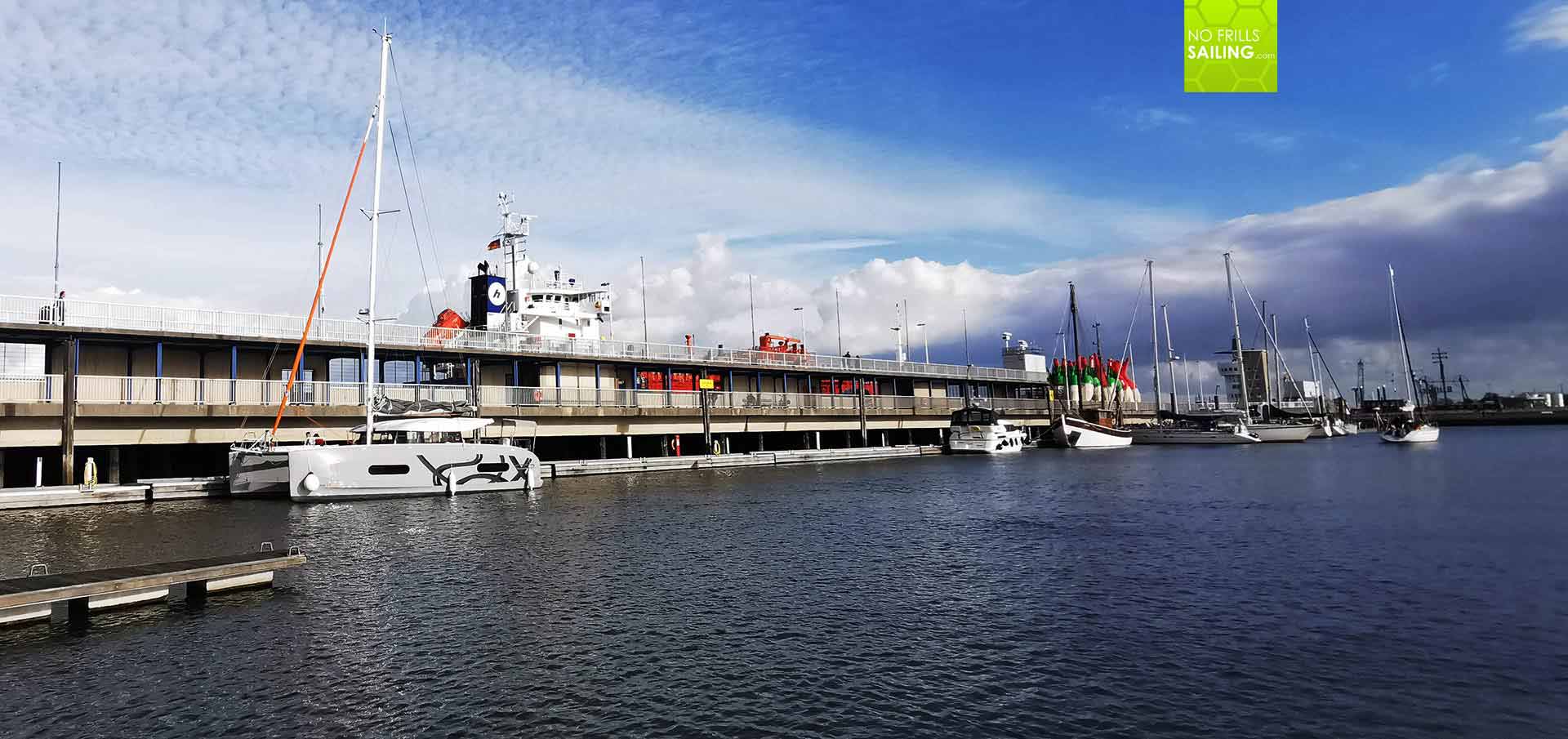
Seeing the cat moored at her berth I feel proud and happy. Proud because it is always such a satisfying thing to land a boat safely, without any damage done to its hull. That is especially valid foor a boat that was trusted upon me and is not my own property. Proud also because for the most part of the sailing journey we´ve had difficult weather conditions which posed a true challenge for me as responsible skipper for both boat and crew. The story I´d like to tell you about now is a retrospective on our last leg of the journey – garnished with some learnings and lessons sailing this multihull has taught me.
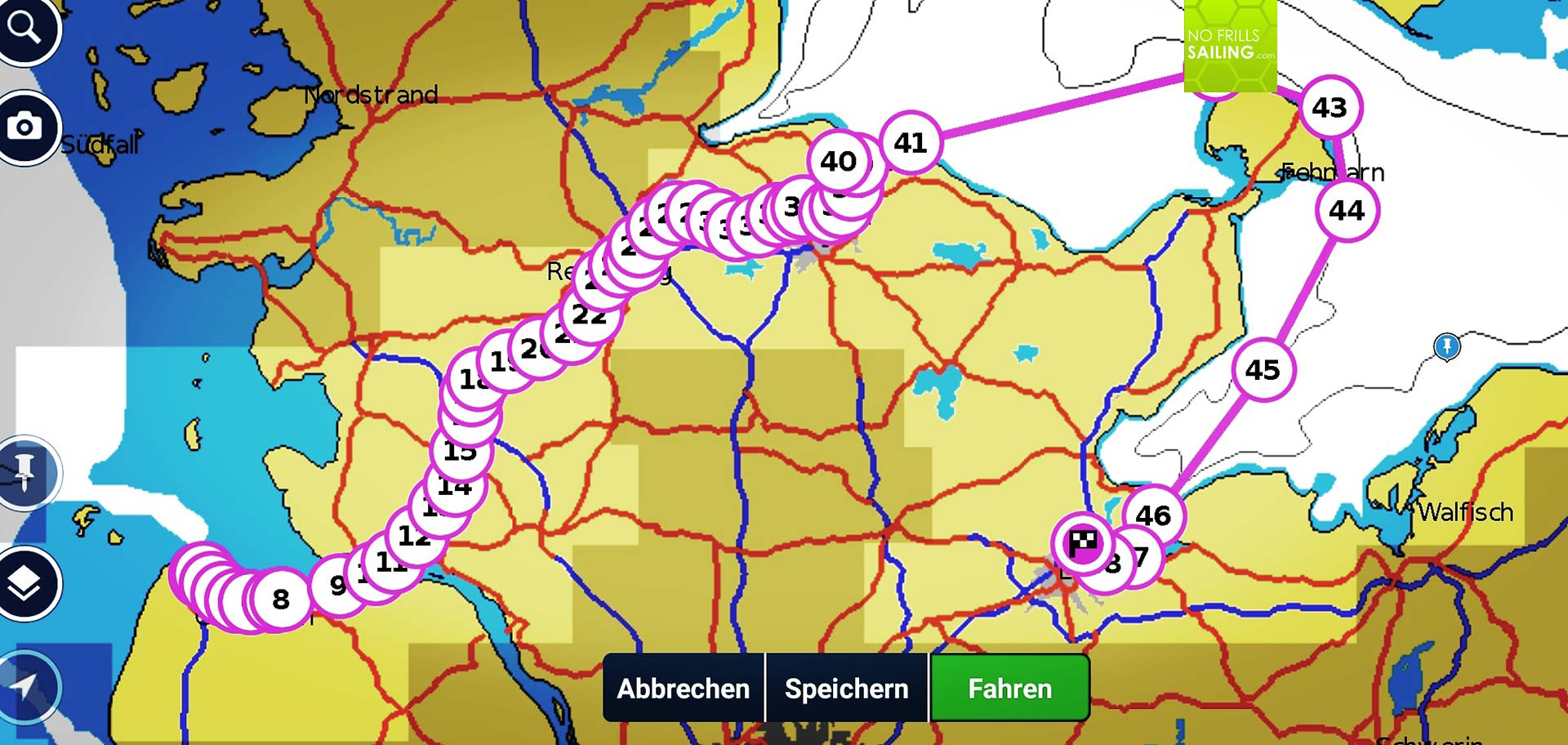
Now, to begin with, this was the last leg of the some 900 miles journey of the catamaran, starting in Les Sables d´Olonne near the yard, crossing the Bay of Biscay into the English Channel and North Sea to Cuxhaven, Germany´s westernmost port where I took over the catamaran one week ago. Let´s start and see which are these “Top 8” lessons learned from catamaran sailing.
Catamaran Sailing Lesson #1: Hospitality
When we arrived, summer was already about to leave us in Germany, temps had dropped well below 20 degrees during the day, slightly above 10 degrees Celsius at night. Chilly, I shall say. There was a fresh Westerly blowing, 15 to 18 knots, and daylight time already shrunk – it smelled like winter up here in Cuxhaven when I unlocked the door and switched on the main batteries to make light.

The catamaran is a perfect place for people to have a good time: My colleague, Olaf, whom I recruited to join me over the next four days, is a keen powerboat skipper but has never been aboard a sailing vessel, had never sailed a single mile and let alone on a multihull. He was new to the game and judging from his instant reaction to the volume and space, which was a long “Woooooah!” I would say that there is no other boat-type out there whatsoever that brings more room, space and volume to the crew than a catamaran.
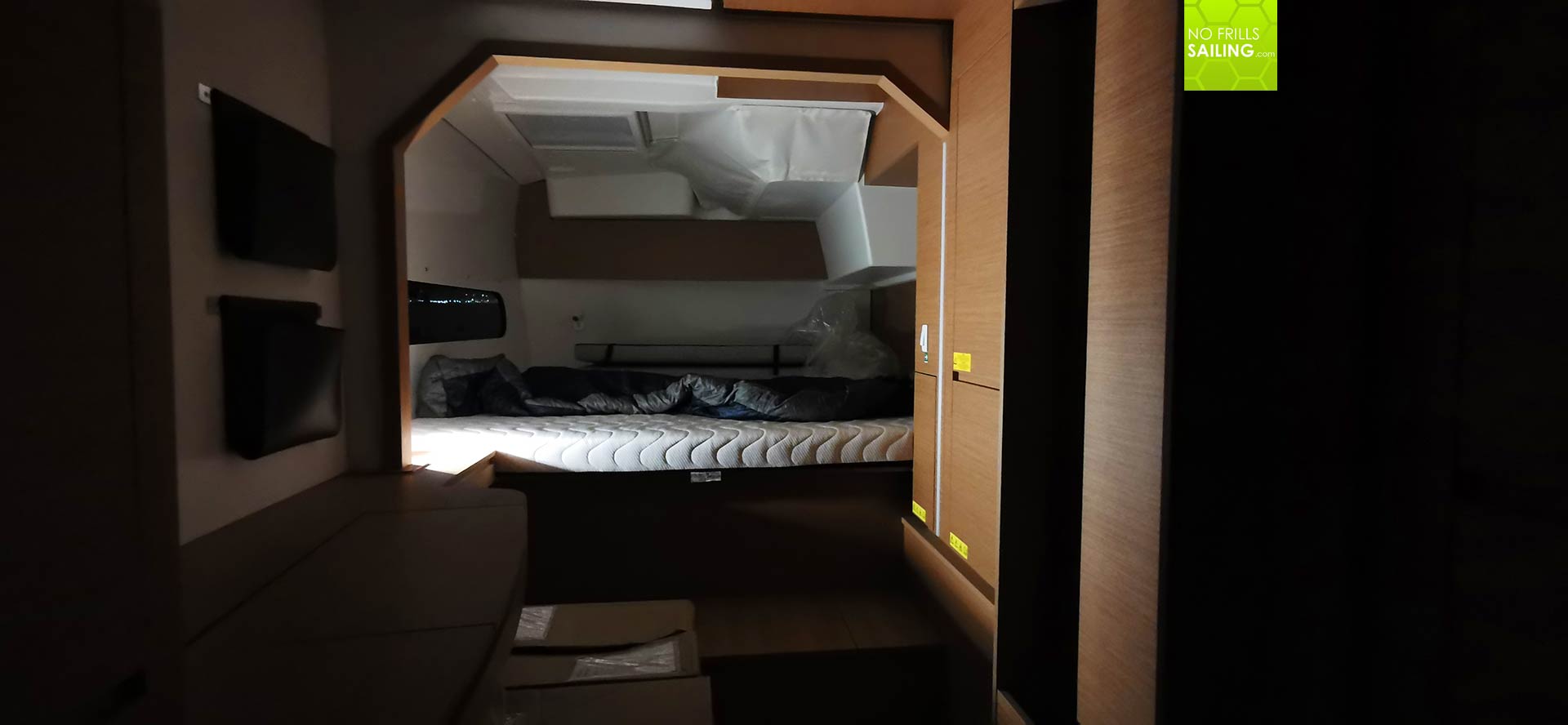
The available space is amazing: A perfect 360 degrees panoramic view in the saloon which is also due to the elevated height of the saloon a guarantee for a perfect outlook. In a catamaran, everybody can enjoy the windows, natural light and the “feelgood”-impression of being high up above the water. Later, when underway, this elevated viewpoint contributes massively to the feeling of being “safe”, even in bad weather (a fact that Olaf will be experiencing in a few days). Also, down below in the hulls, the sheer size of the cabins is amazing. The big, big hull windows together with the skylight hatches make for light-suffused cabins, matched again only in yachts of +50 feet in size.

My clock was waking me up next morning – or shall I say: Next night – at exactly 0330 a.m. which was a torment. We got up in agony and I tried to cheer up my crew, which was completed by Kai Köckeritz, Chief of Editors of German sailing magazine “Segeln”, with a freshly brewed hot coffee and some cheerful jokes about hard salts. An action that was honored by grim faces and some half-motivated approval.
Catamaran Sailing Learning #2: A stable Ship indeed!
Why have we got up so early? Well, that of course was due to the tidal calendar. Cuxhaven is situated at the North Sea and as we had to enter Elbe River in the upriver direction I chose to go right at low tide when water begins to rush upriver, creating a push of up to 4 knots, to enter Kiel Canal. That was the first low tide of that day and I didn´t want to waste a full day only to go in broad daylight. So we drank our morning coffee and talked about casting off.
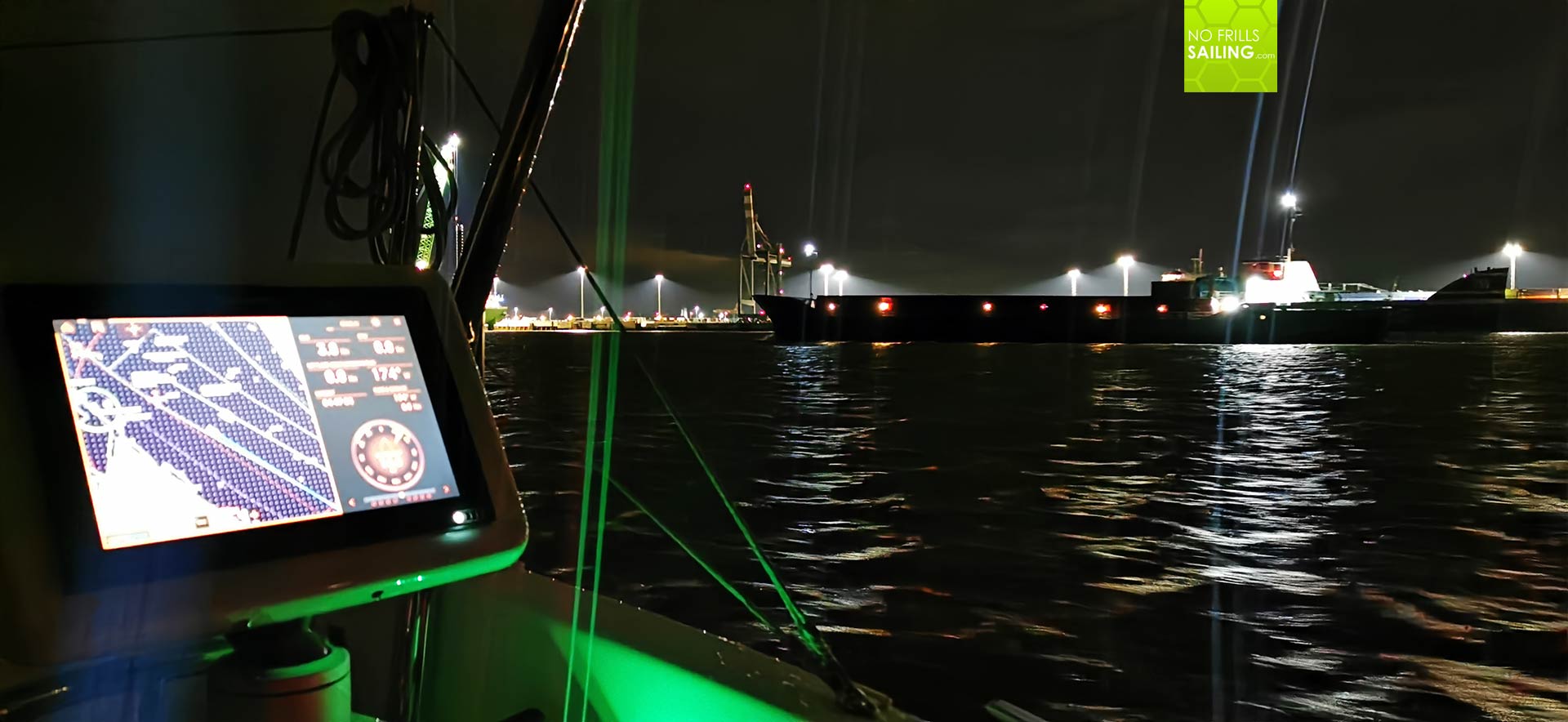
There was much wind that morning, 14 to 17 knots, but as the marina was all but empty (sailing season is over, rarely any boats moored here) I had plenty of room for manoeuvering. With awe and shaking legs I still vividly remember my casting-off-action with that very same ship in Brest, being wedged between racing trimarans in fear of producing a crash – this time, all went well and in a professional manor and 5 minutes later I handed the wheel to Kai, who was aboard to produce a test article for his sailing magazine.
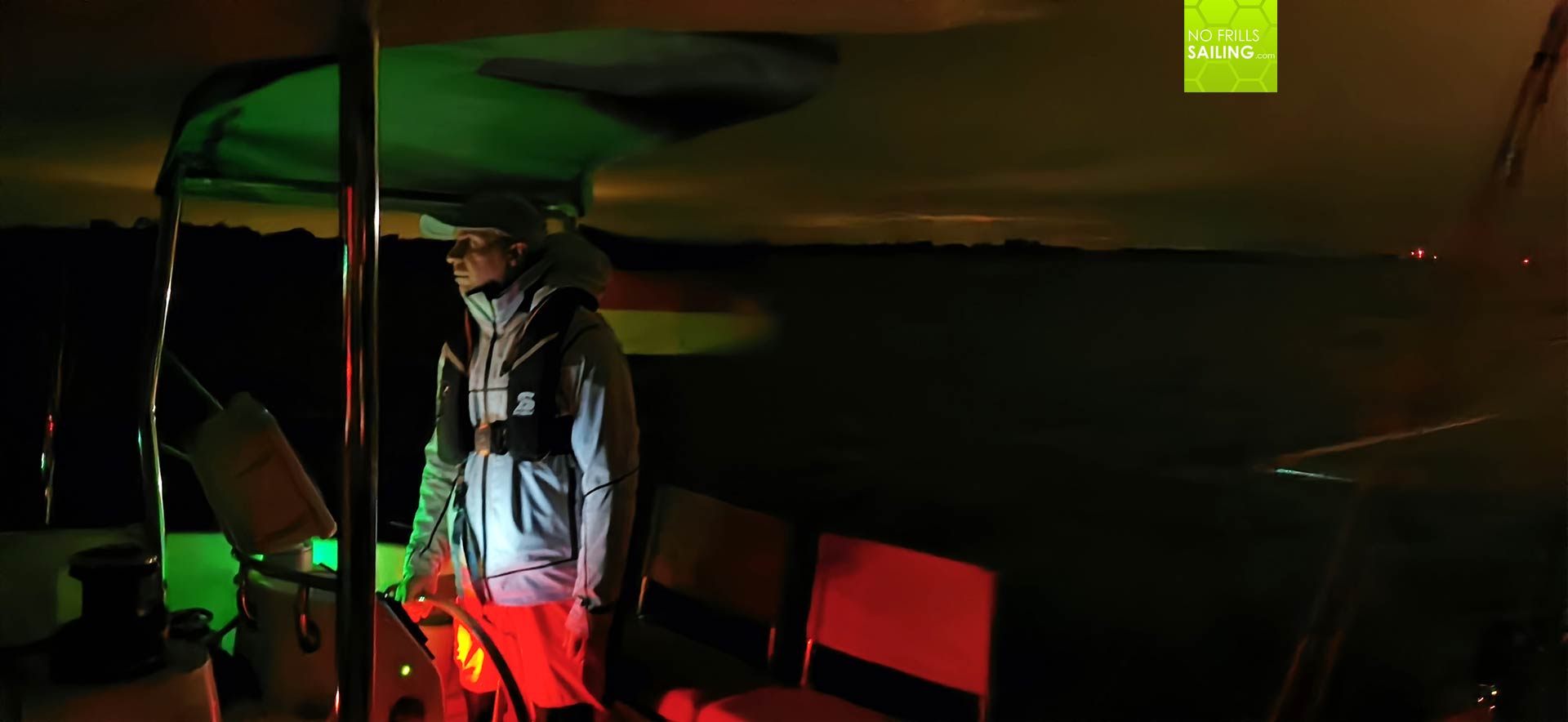
Outside it was even rougher. As it is the fact with all rivers and tidal-prone estuaries, you get the normal flow of the river against the water that is pushed inwards by the moon. Choppy short waves partnering with quite some swell fanned by the wind that was blowing from West. The product was quite a nice turmoil of cross-seas and short, choppy, unpleasant waves. As Kai mentioned quickly: Most of it was filtered by the double-hulled catamaran – even bigger swell that was produced by passing freighters and other pro-shipping couldn´t cause bigger trouble. A plus definitely for the cat.
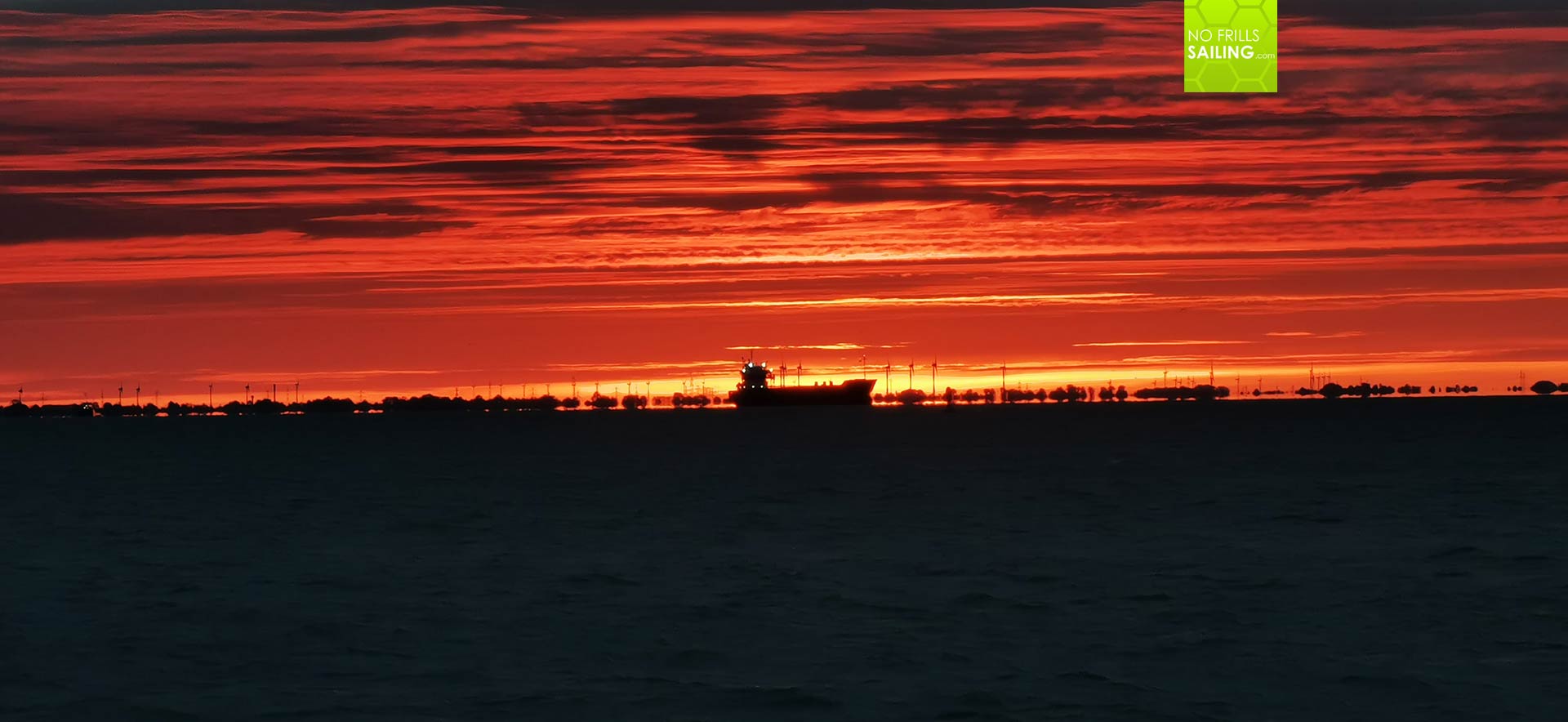
No matter how choppy the sea got, there was rarely any heeling nor rocky motion. Of course, the boat was working its way through the water, but never unstable. “You never had to grab onto something”, Kai mentioned and even our half-filled coffee pots stood safely on the dinner table with no intention to slide off of it. This is a unique feature of a multihull: Very stable and safe.
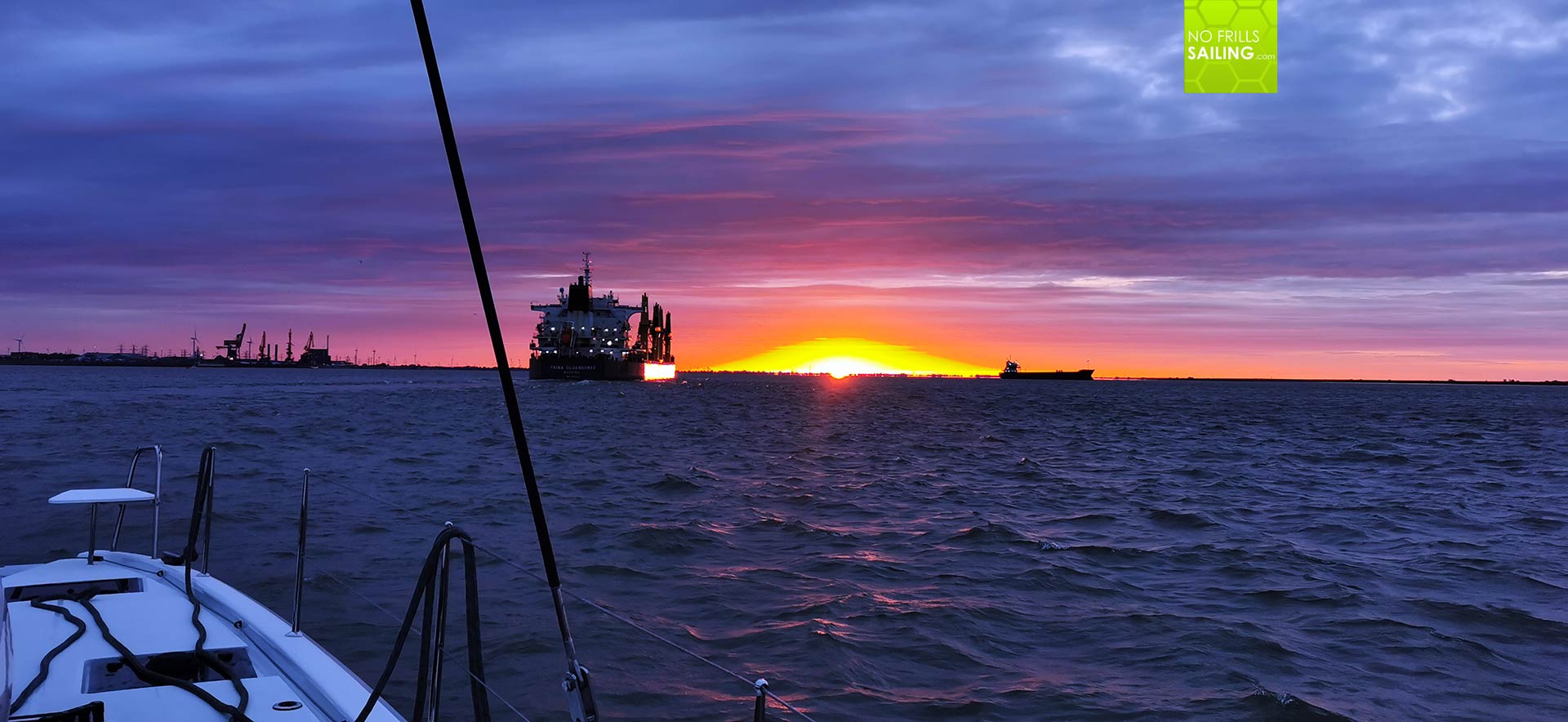
I have read quite a lot about capsizing and stability curves of catamarans versus multihulls and indeed in really heavy seas or honest offshore-adventures I would always for sure choose a mono, but for a “holiday-boat” this is absolutely perfect – and much, much more stable and sturdy than I had previously thought. Some weeks back, when I was delivering the first catamaran to Santander/Spain, I had to master 4 metres of waves and winds past 35 knots true – no fun, of course, but my lesson learned was: This catamaran is much, much more stable that I had always thought.
Multihull vs. Monohull: Manoeuvers
The sun was slowly starting to come up and flooded the morning with her glorious red, immersing the whole sky in flaming colors, which was absolutely breathtaking to observe. The changing that the light brings to both nature and our still a bit tired souls. I called the Kiel Canal locks via VHF and asked for passage into the channel that connects North Sea and Baltic Sea, which was granted immediately. Taking over the helm I instructed Kai and Olaf on how to tie up the cat inside the sluice chamber.
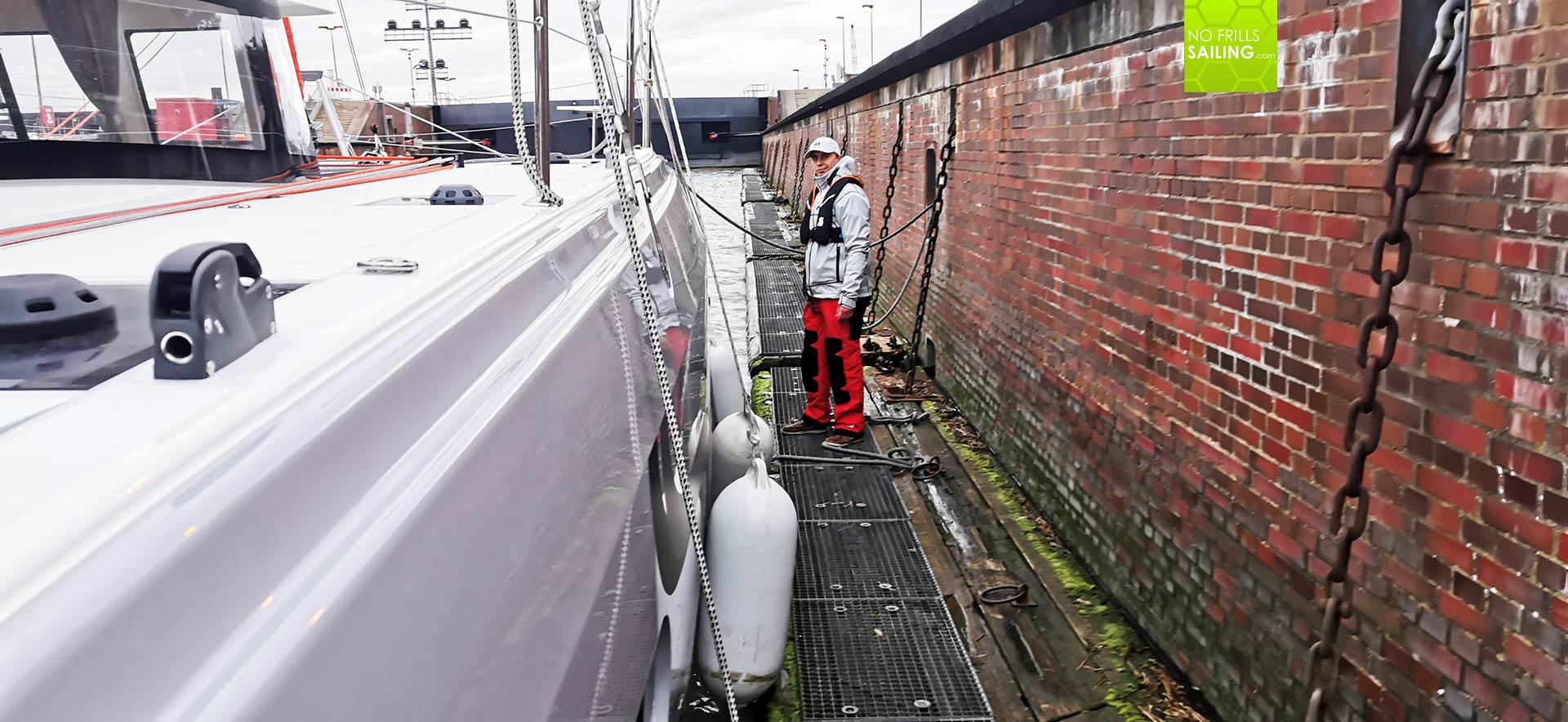
That brings me to another big thing when talking about catamaran versus monohull: The manoeuvers. I mean landing and casting off. On a cat this is solely done by utilizing the two main engines – the rudder blades will be locked and shall never be unscrewed during proceedings. When I first came aboard the catamaran I must admit I felt absolutely overwhelmed and a bit lost. It felt very uncomfortable and wrong in some way. But I also noticed that people with a lot of power boat experience don´t find it awkward to steer the catamaran only by using counter-rotating screws.
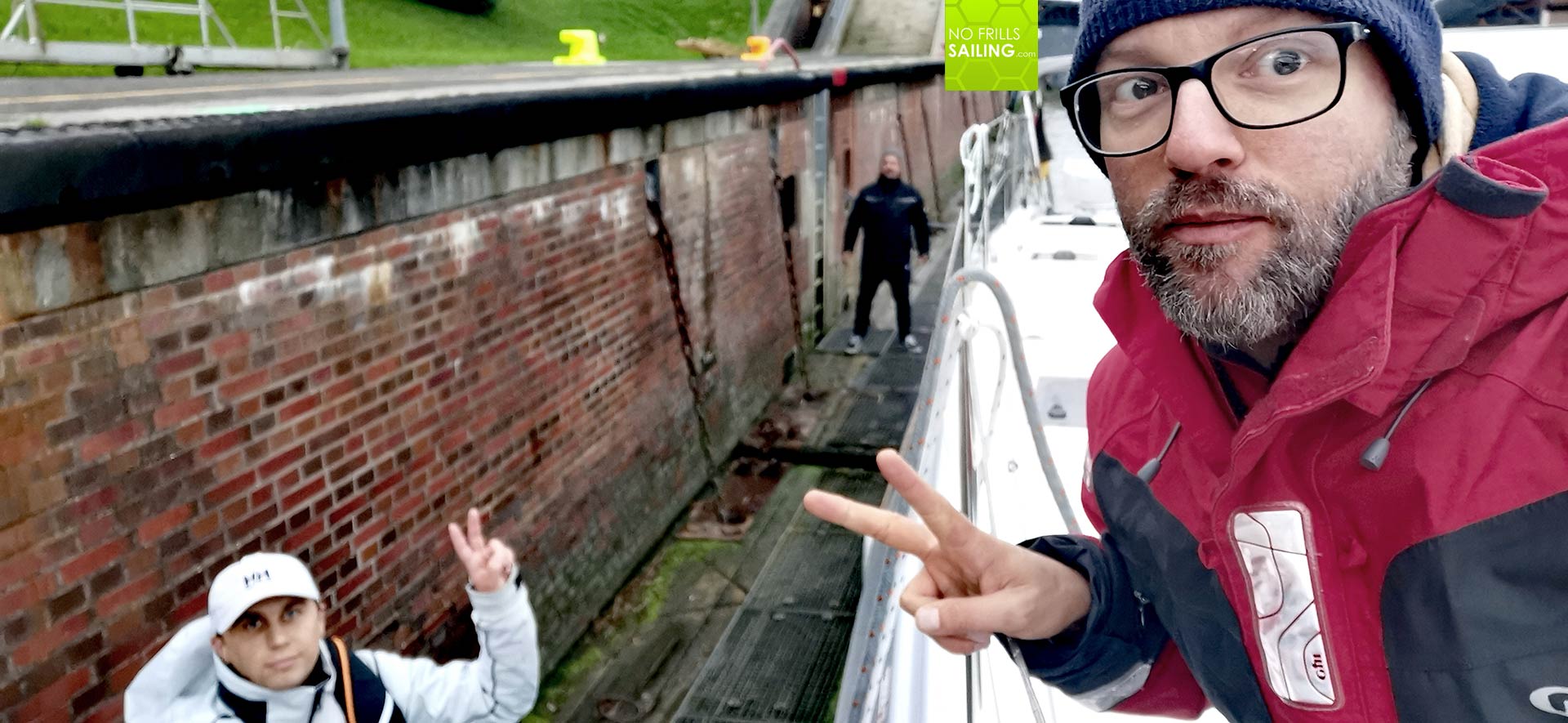
Well, this time in the Kiel Canal lock chamber it felt a bit better. I guess this is natural as one´s skills will become better and better the more often one practices. I now knew that I should go for shorter but much more powerful pushes when manoeuvering and it worked quite nicely. I was able to land the boat on spot inside the chamber. I still feel much safer and more comfortable with a monohull, a keel underneath, no instant drifting in the smallest breeze, but I must say, I had become more self-confident over the time.
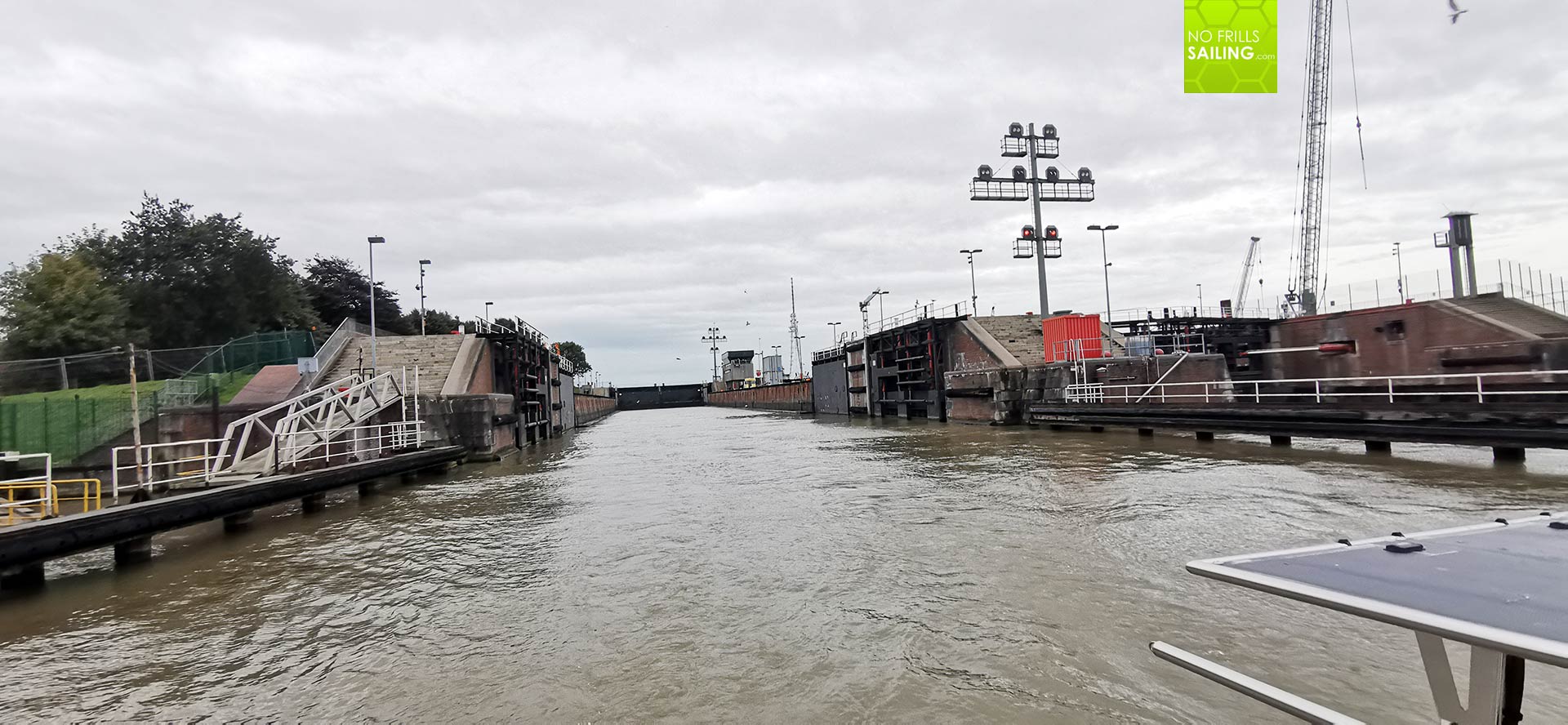
As we were motoring out of the chamber after a slight sea level-change into the Kiel Canal, I again handed over the wheel to Kai and we talked about manoeuverability on a catamaran versus a monohull. He brought up another interesting aspect: Vision. Well, on a monohull, no matter how long the boat gets, you can always see the boundaries of the boat and can pretty well estimate distance. That is harder on a cat. This is not a boat, this is a real estate! So, at least for the bow that is situated diagonally across from the man at the steering you need a person to tell distance in the front.
Catamaran Lesson #4: Time goes by rather quickly
Kiel Canal is a very impressive piece of engineering. It was built in the years 1887 to 1895 and inaugurated under the name “Kaiser Wilhelm Kanal”, re-named of course into “Kiel Canal” after the Second World War, it has a length of some 95 kilometres and is one of the busiest waterways in the world. 2018 some 30.000 ships have traversed the channel and it still is the shortest way between Baltic Sea and North Sea. For pleasure craft like ours the channel is a mixture of boredom, interesting view on northern German nature and highlights, when a big freighter, container or ferry ship is passing (and even more exciting, when overtaking).
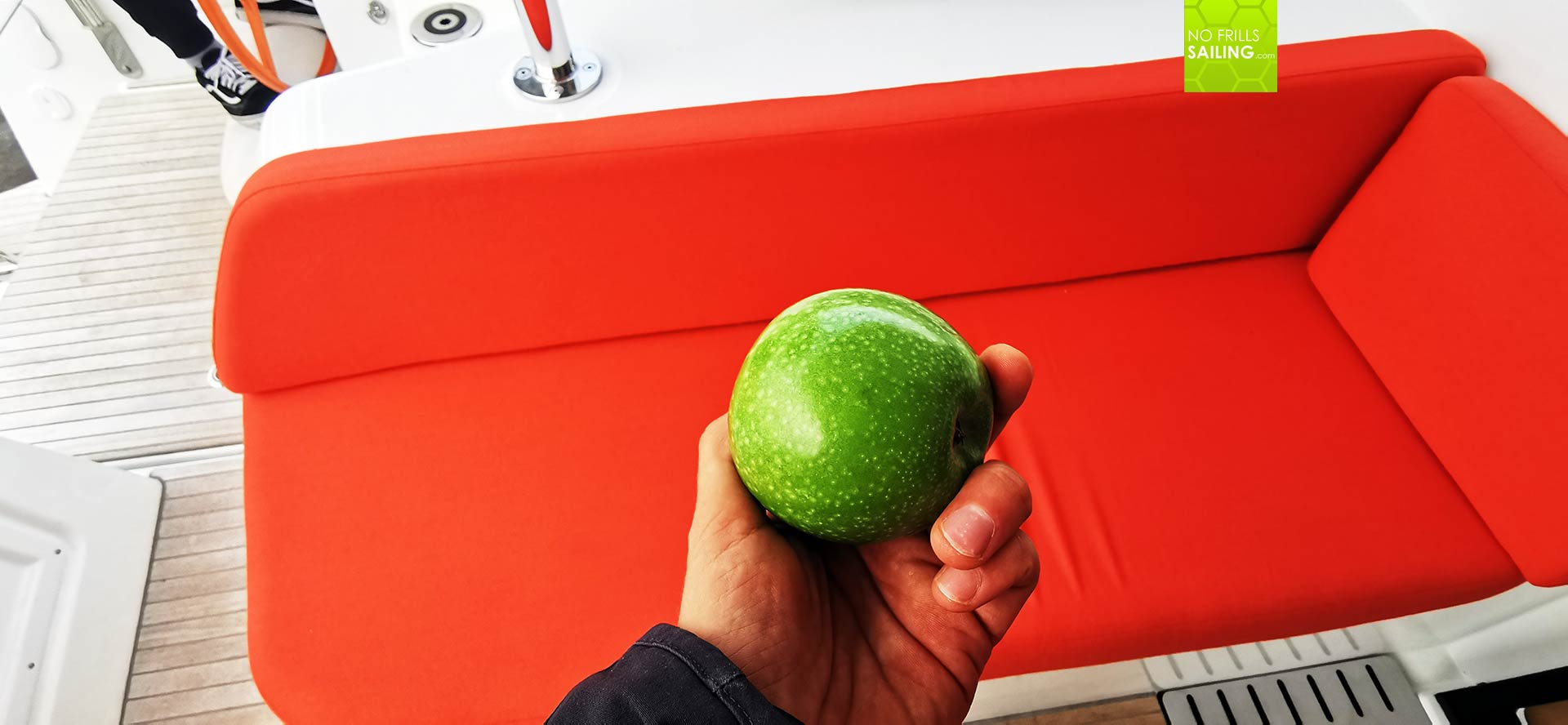
As we all have travelled the Kiel Canal multiple times the excitement was a bit limited. So as steering through the channel (autopilot is strictly prohibited) I feared that boredom might kick in fast, but it did not. That was due to the special properties of a catamaran, I am sure. The cat offers various, very interesting and attractive places where you can place yourself and do … nothing. That is the bow, the net between the bow, the roof, the cockpit of course and even being inside “down” in the cabins is nice because the big windows offer a great panoramic view. Time went by rather quickly, which astonished me.
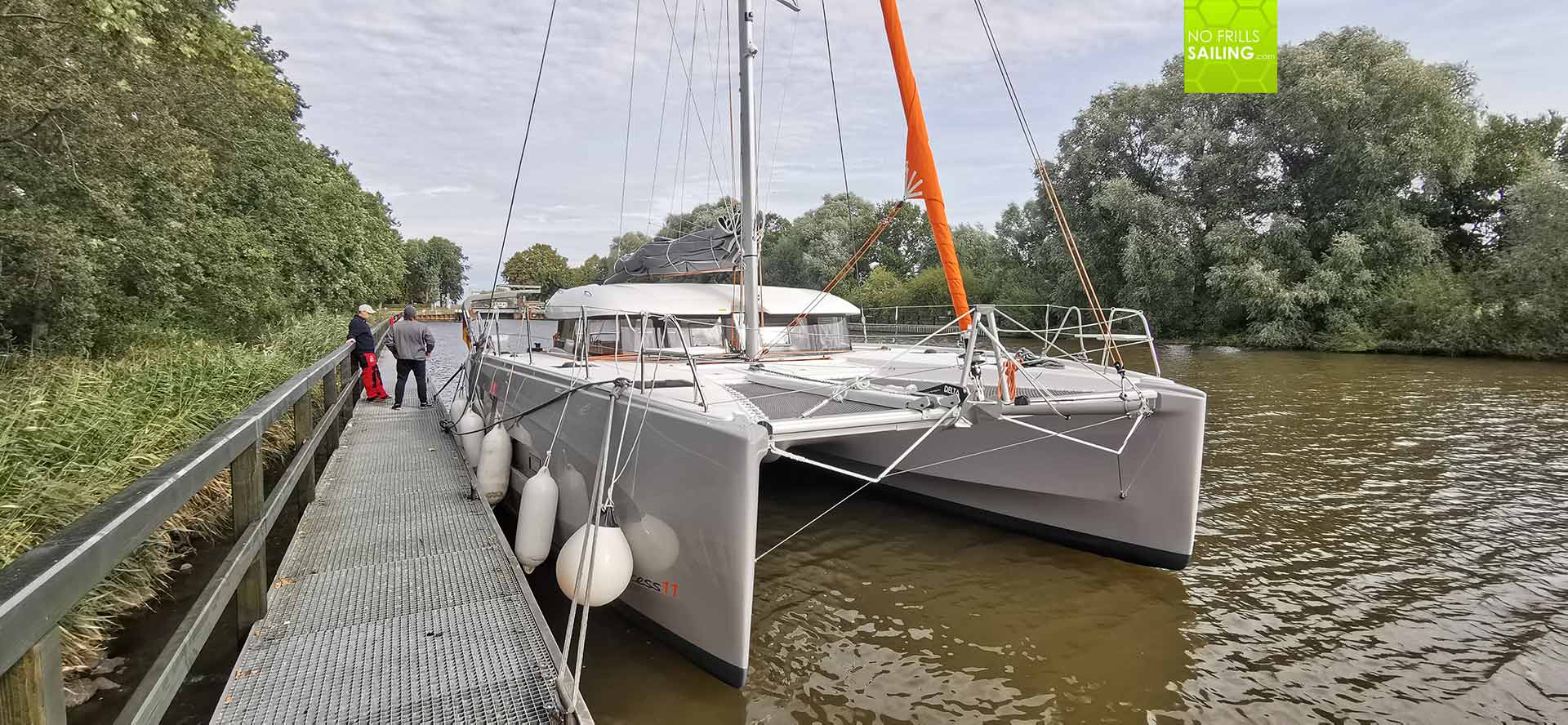
Travelling on the channel as a sailing vessel is only allowed in daylight time. You have the choice: Either you go at flank speed, of which maximum allowed is limited to 7 knots or you take it a bit smoother and have your trip upgraded with a stopover. If you choose to go fast you have to enter the channel as early as possible, race through (in roughly 9 hours) and be happy to being locked out in Kiel on the very same evening. For me, this is too much stress, so I always opt for the second choice with the stopover.
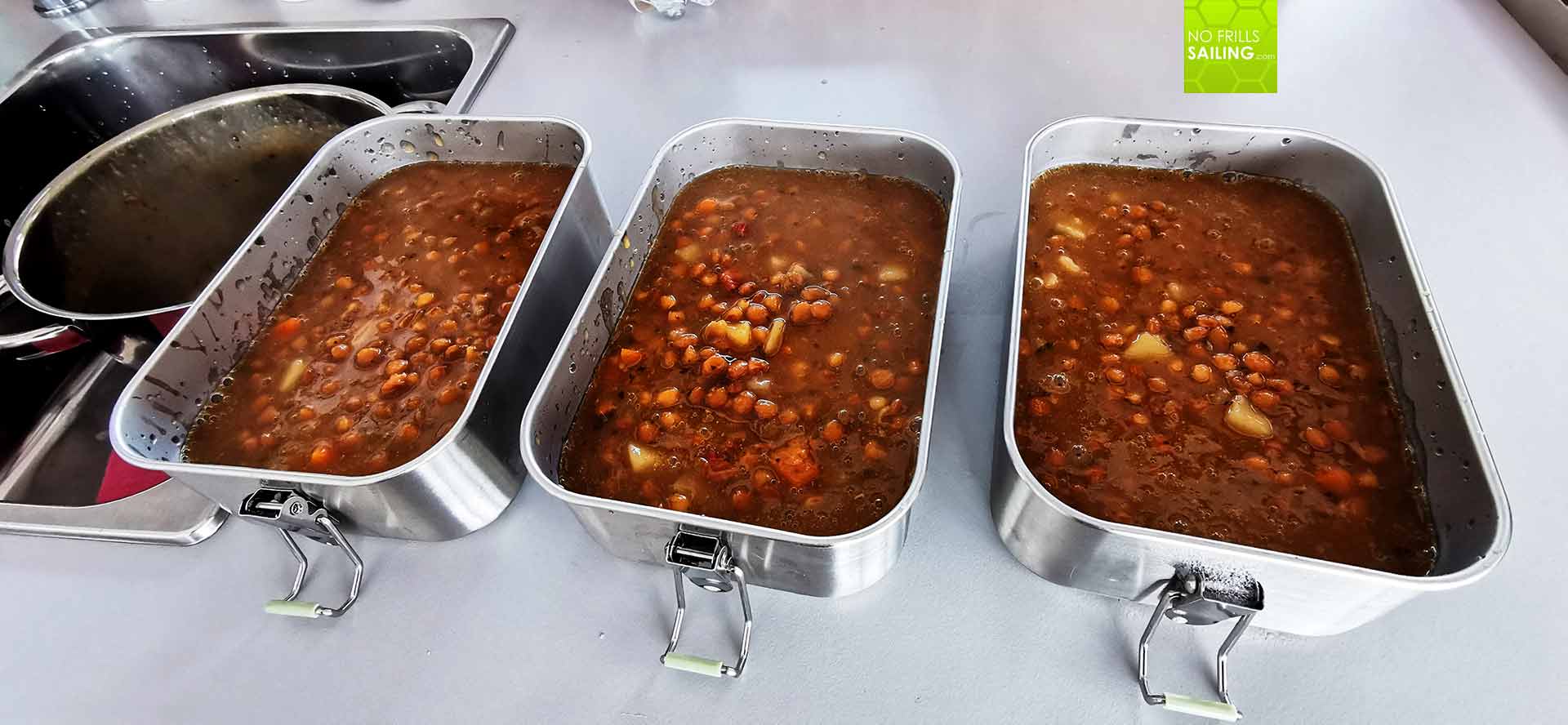
This is usually done in Gielaukanal, a branch canal that connects Kiel Canal with a smaller river to the North that will also flow into the North Sea quite a bit to the North. The Gieselaukanal is a wonderful habitat, very quiet and as almost all pass by this is a resource of tranquility and calmness. I love being here over night: No shore power, no people, no cars, no nothing. I told Olaf, when he asked where we go: “It is so deserted, that if you are lucky, you may see a cow or two.” After mooring in Gieselaukanal, we went off to a short walk nearby the channel and … he was lucky indeed and saw a bunch of cows. And their moo – together with the distant Swooosh of windmills – was the only sound we´ve heard that night.
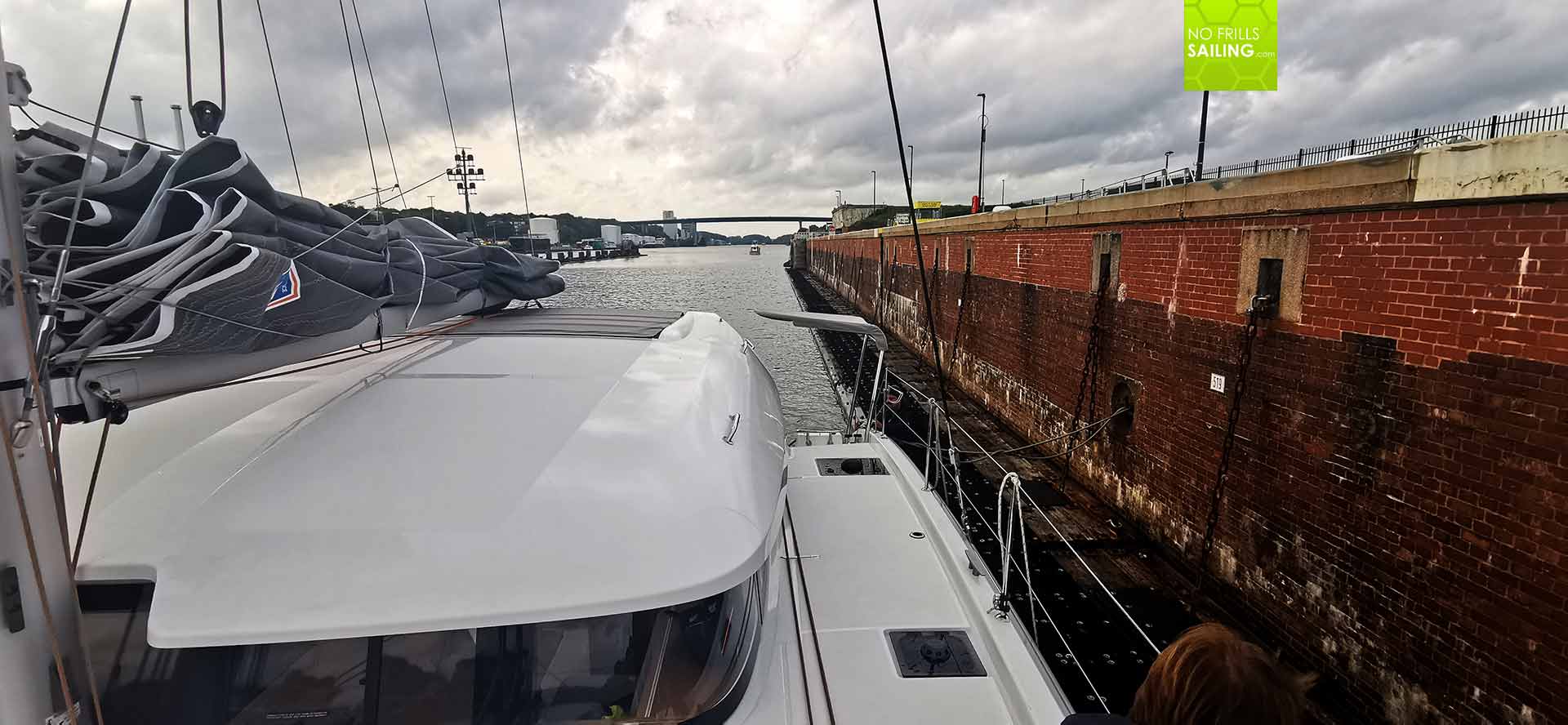
A night that was so calm that we all, upon getting up, felt unusually satisfied, happy and relaxed. Casting off from Gieselaukanal meant another 4 or 5 hours to Kiel, where the second locking process flushed our catamaran into the Baltic Sea. A rather emotional moment for me as this meant that these hulls have now been touched by the fourth kind of water: First was the salty seas of the Atlantic Ocean. Secondly the English Channel followed by the North Sea. And now a less salty version that is my “home” ocean, the Baltic Sea. “You´ve reached your home sailing area”, I whispered to the boat.
Sailing a Catamaran, Lesson #5: Quick & Just
Immediately after leaving Kiel locks I landed the boat briefly and we took on another journalist. This time Jochen Halbe, a veteran yacht-journalist in his high seventies. Jochen is a well-known “base metal” of German yachting and I like him very much, having had sever testing occasions and sea trials on Beneteau boats with him. As Kai promised (with a smile) that both would work together nicely, I now had 2 journalists aboard ready to see the catamaran sailing: And sail we did!
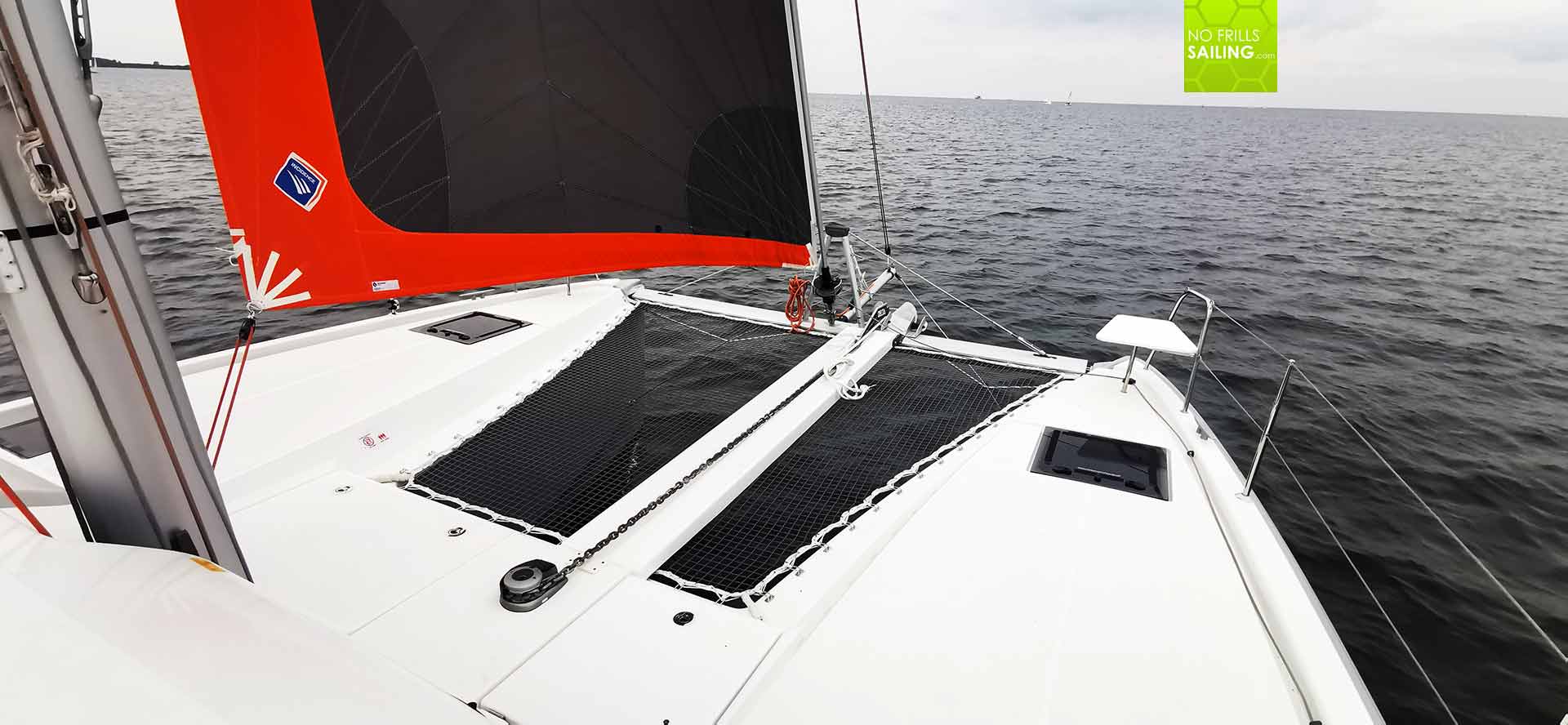
Just as fresh as the whole week we met a nice 13 knot breeze. We hoisted mainsail and jib and killed the engines, both guys eager to take the helm. As I wrote in my previous articles, sailing properties of the Excess 11 are astonishingly excellent: And that also was the verdict of my two guest from the writing guild. Even in calmer puffs with wind speeds not exceeding 7, 8 knots, we still made some good speed. Especially astonishing was upwind speed which in no way was slower than on a multihull.
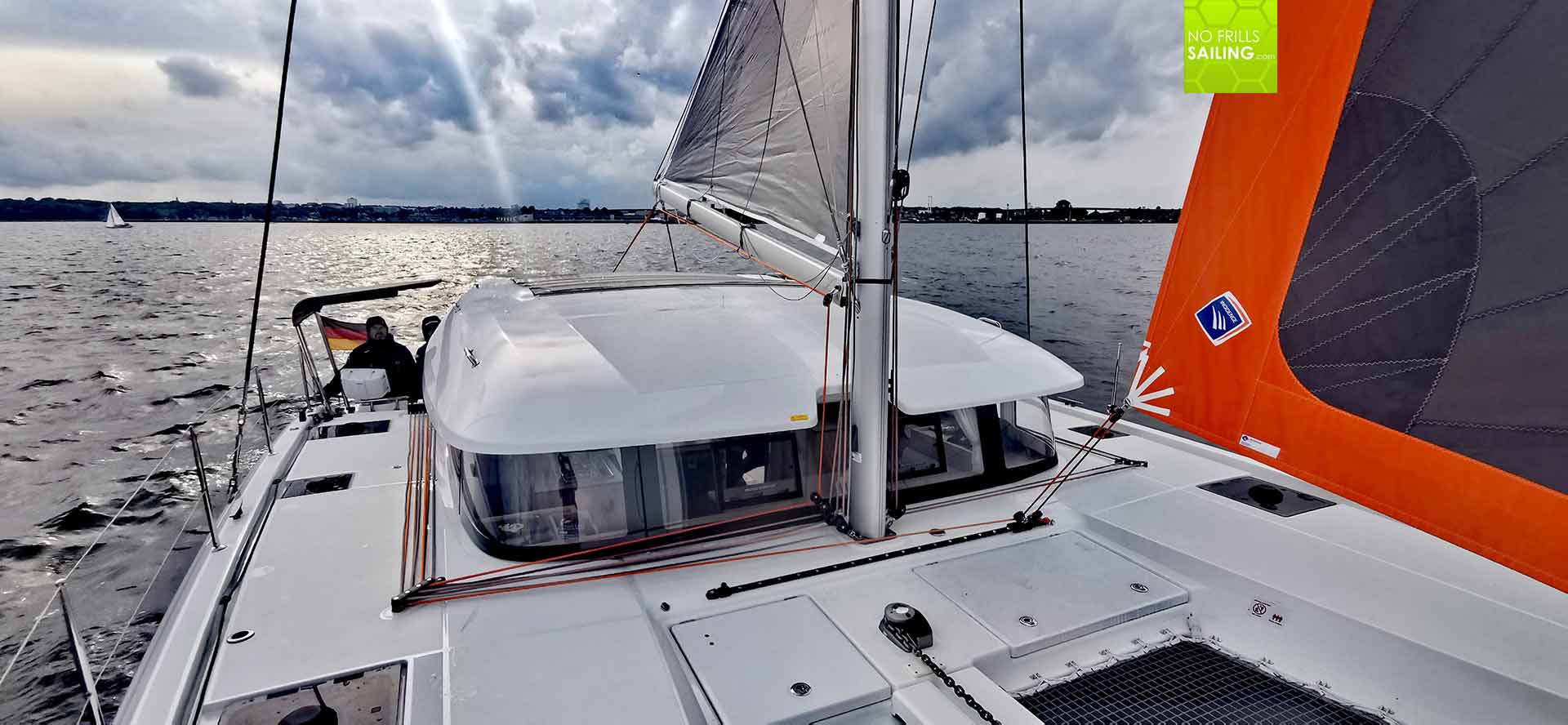
We sailed out into the Kiel Förde to test the catamaran on all points of sail. Being fasted of course on a reaching course, the cat clocked in just under two-digit numbers as wind was just below take-off-speeds. Nevertheless, especially Kai was very impressed: “How nimble she feels on her rudders!”, he shouted between the manoeuvres. Tacking is a no-brainer on the catamaran, being equipped with a self-tacking jib. You simply just adjust course, the rest is automatic.
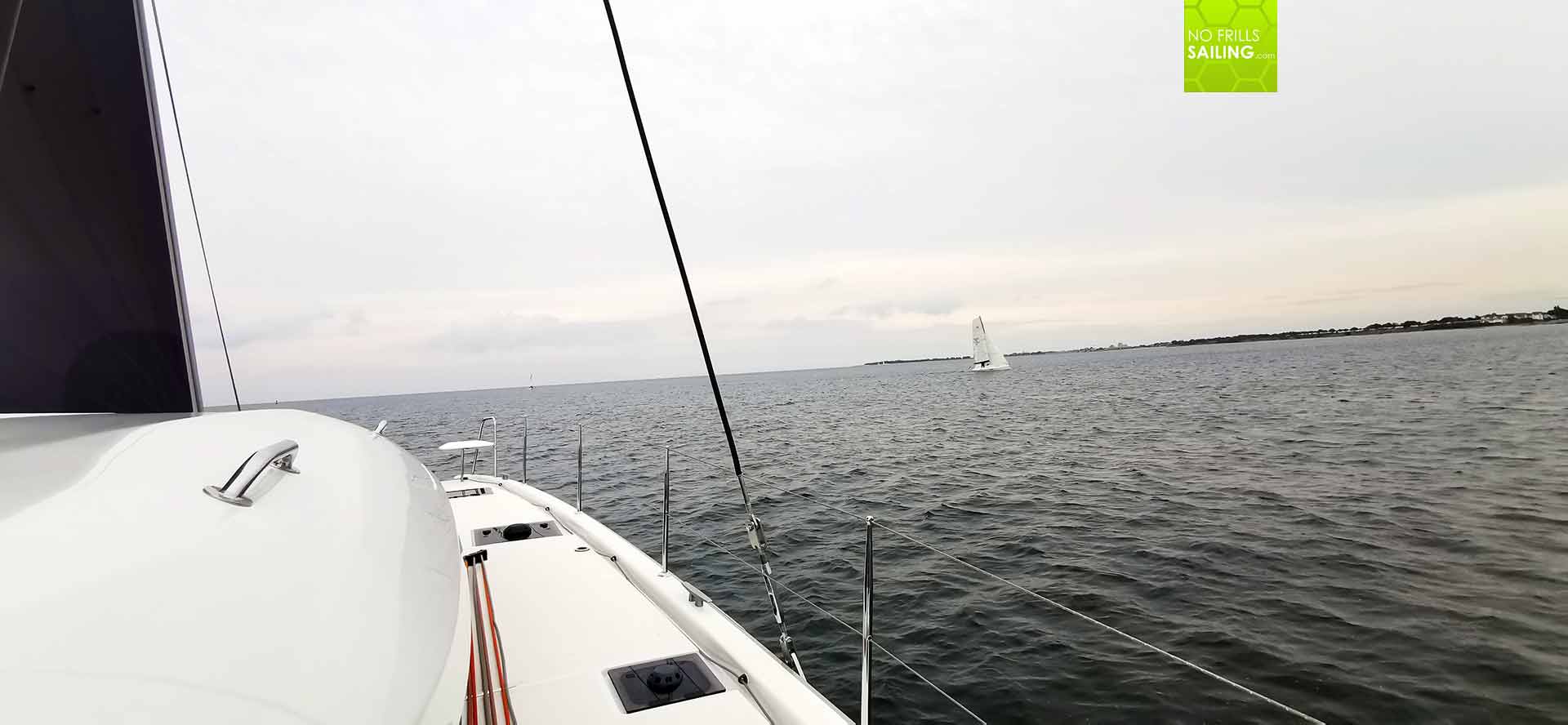
We sailed along and performed one gybe after another, tacked multiple times just like we were a beginners course in sailing. I had the journalists partially steering to get a feeling for the boat and partially working the winches. Winches? The one winch, I shall say, because the whole running rigging needed to control either line aboard the cat is run via one single winch. Pretty convenient and easy: The Excess 11 is fully single-handed-capable.
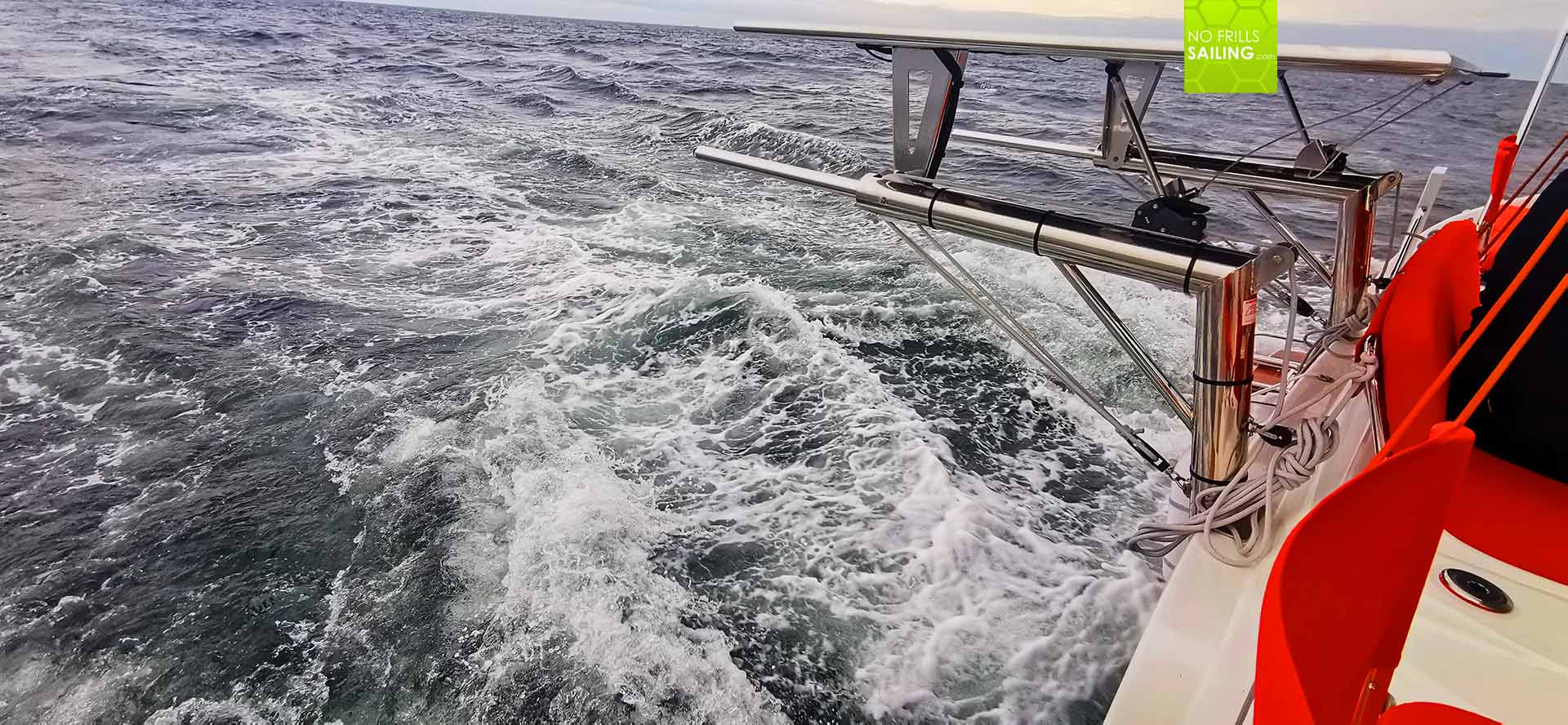
At one point I recognized a pretty familiar shape: The square top mainsail with a small fish on it. My heart jumped and I smiled as a Seascape 27 – my boat! – crossed our path at high speed. Oh boy, how much I loved being on that big luxurious catamaran, but how much more I would have loved to be aboard my GEKKO! But, back to my job: As wind slowly died down and we sailed back into the Kiel Bay, waves reduced to almost zero. Now the cat even more showed his performance. With no swell whatsoever affecting the hulls in the water, we were even faster in less wind.
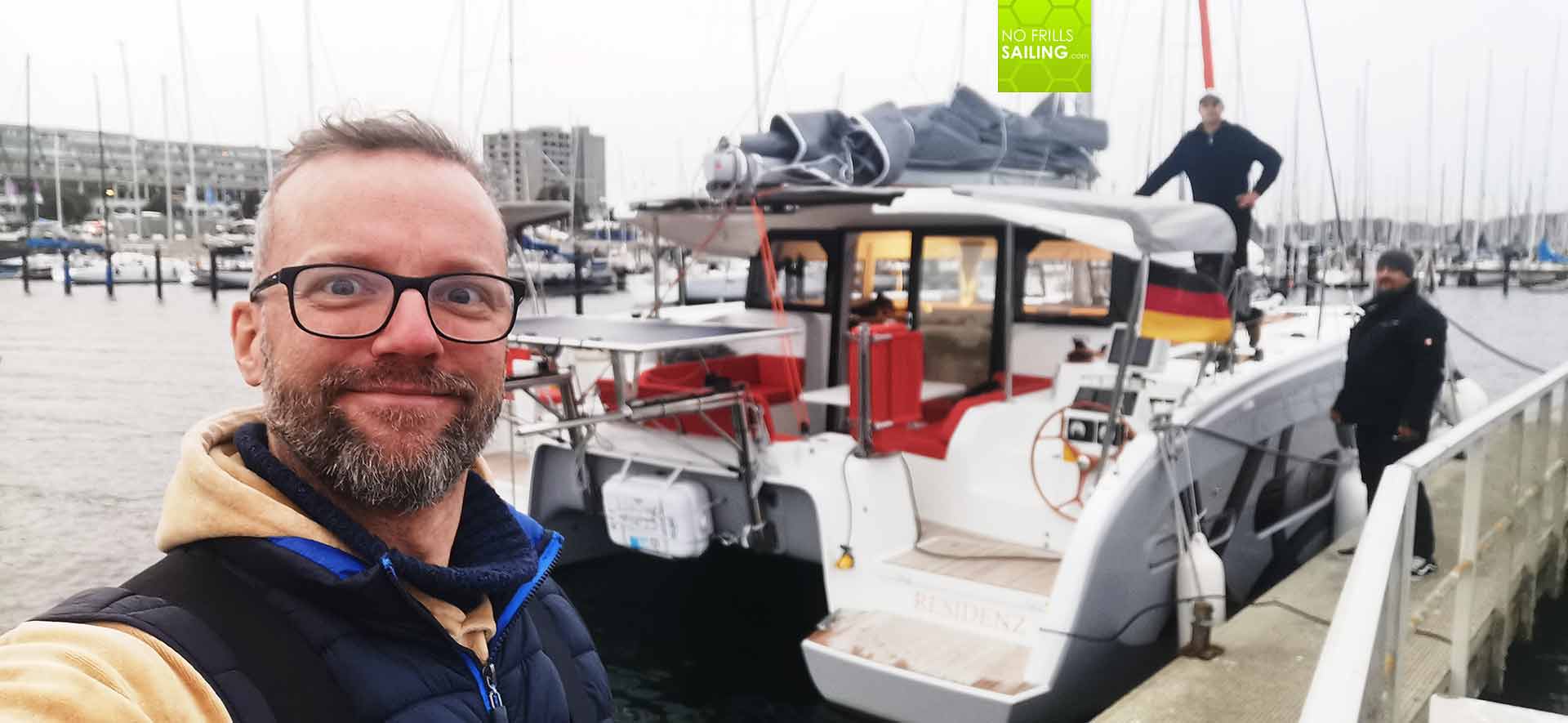
After mooring the catamaran at famous Kiel-Schilksee marina, we said “Goodbye” to our journalist guests Kai and Jochen. I am really excited to read their articles in the coming issues of “Segeln” and “Skipper” magazines and look forward to maybe read about their insights and findings. It is always a real pleasure and fun, but also interesting, to have sailing journalists aboard as they of course have the broadest view over the various boats currently available. For now I was happy to having had the chance to present the catamaran in almost perfect sailing conditions that day.
Lesson #6: Heavy Weather with a Catamaran
The next day proved to be tricky and completely different in all matters. As our guests had left, Olaf and me remained the sole crew. Wind had increased over night so that this morning some 20 knots already pushed and rocked in the rigging. Thanks to a very forward-looking harbormaster in Kiel we had been assigned a berth very good protected by also very near situated at the entrance to the marina. We therefore were able to cast off without any problems and in a very safe manner. Manoeuvering inside the pretty narrow marina prone to these gusty strong winds would have been a lot more … exciting.
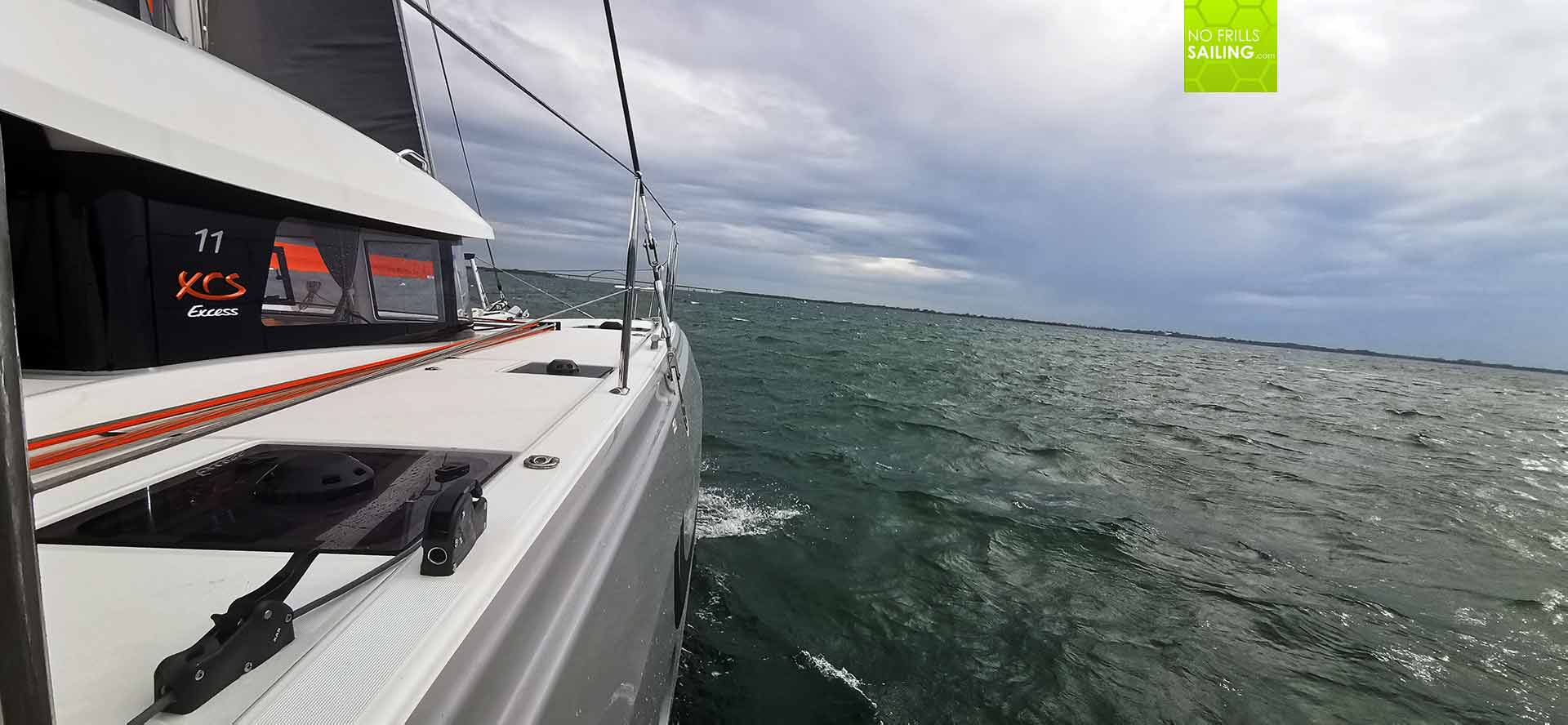
Right after leaving the berth I had our general course put into the auto pilot and mainsail hoisted in a matter of a minute. I decided to have the first reef in the mainsail right away since weather forecast was promising winds of 22-24 knots for the whole day. Here comes a specialty of the Excess 11: As the official rigging-chart shows, the boat may be sailed with full canvas in apparent wind speeds of 23 knots. So the first reed in the main is recommended at 24 knots AWS. Waaaaaay to much for my taste! I start to reef the cat at 18-20 knots (depending on wave heights) and with speeds still as high this proved comfortable for me.
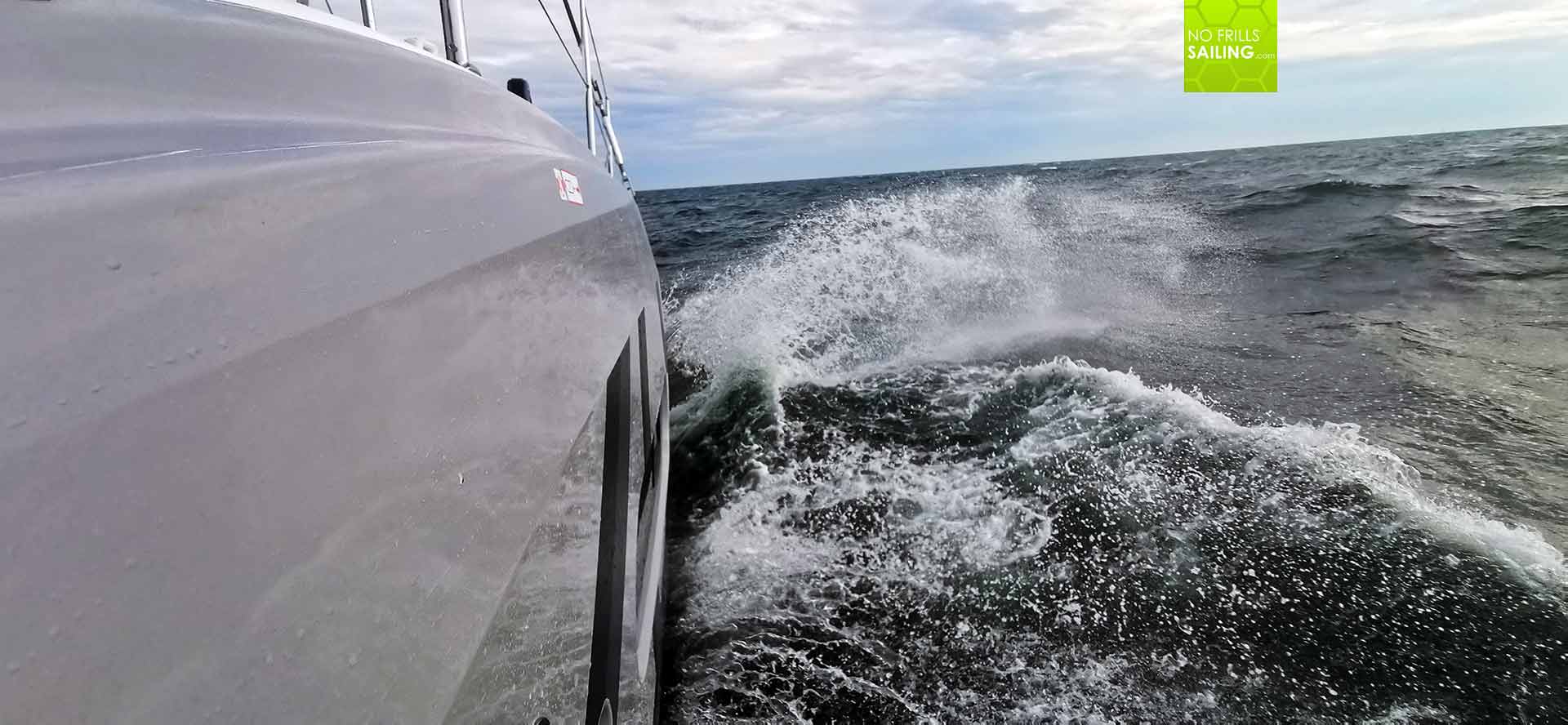
The catamaran simply flies. I cannot describe it much better than this: Even with some 14 tons of displacement at hand, this cat is as nimble as a boat can be. She is absolutely gorgeous and fun to sail, even in a string breeze like the one we´ve had now. Wind coming it at some 50 degrees AWA, 7 to 8 knots SOG were no problem. Our wake was foaming in rage and my smile was bright. Even Olaf – usually going much faster in his power boat – couldn´t help but smile as well. It is just fun as hell when a boat sails this nimble and quick. Unfortunately this perfect sailing morning wasn´t remaining that perfect as weather further deteriorated and wind prediction (again) proved a bit off reality. A nasty swell began building up and quickly around noon wave height was at 1-1.5 metres, wind speed further increasing.
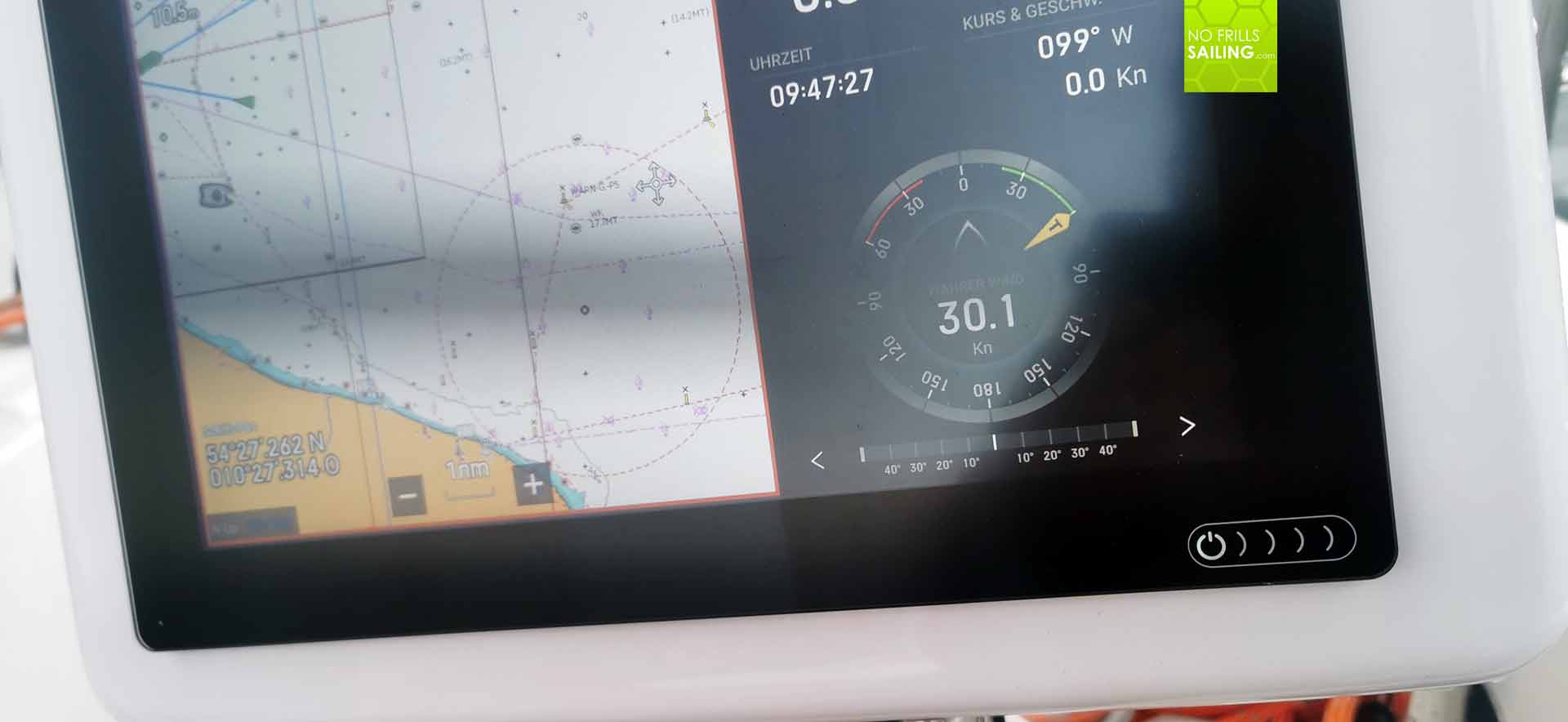
Now, from my past “storm” experience with the Excess 11 on the Biscay Bay – wind speeds around 26-28 knots, wave height up to 3 metres – I knew that the catamaran was to sail safely and sturdy, although very rocky. On a beam reach, mind you. Today it was different: We went upwind, 40-45 degrees in similar wind speeds (but admittedly smaller waves). It was a rocky rough ride, boat speed still around 7 knots, but very unpleasant. This is what I can say about “heavier” weather in a catamaran: The higher the waves the more unpleasant the fact that each wave will work on the boat twice will get. Olaf, although not turning white and getting seasick, had a hard time roaming about on board in our rocking multihull. But the most interesting lesson was yet to come …
Learning #7: Upwind Tacking & Leeway
As I cursed the wind.tv app for the hundredth time, wind direction had changed to due South, which was unpleasant because that was the direction in which we wanted to sail. After passing the Island of Fehmarn we entered my “home turf”, Luebeck Bay. From the Northermost end of this large bay area it is a beeline distance of some 30 miles to Travemuende. 30 miles at 7 knots? A fast 4 hour-trip. Well, not so today.
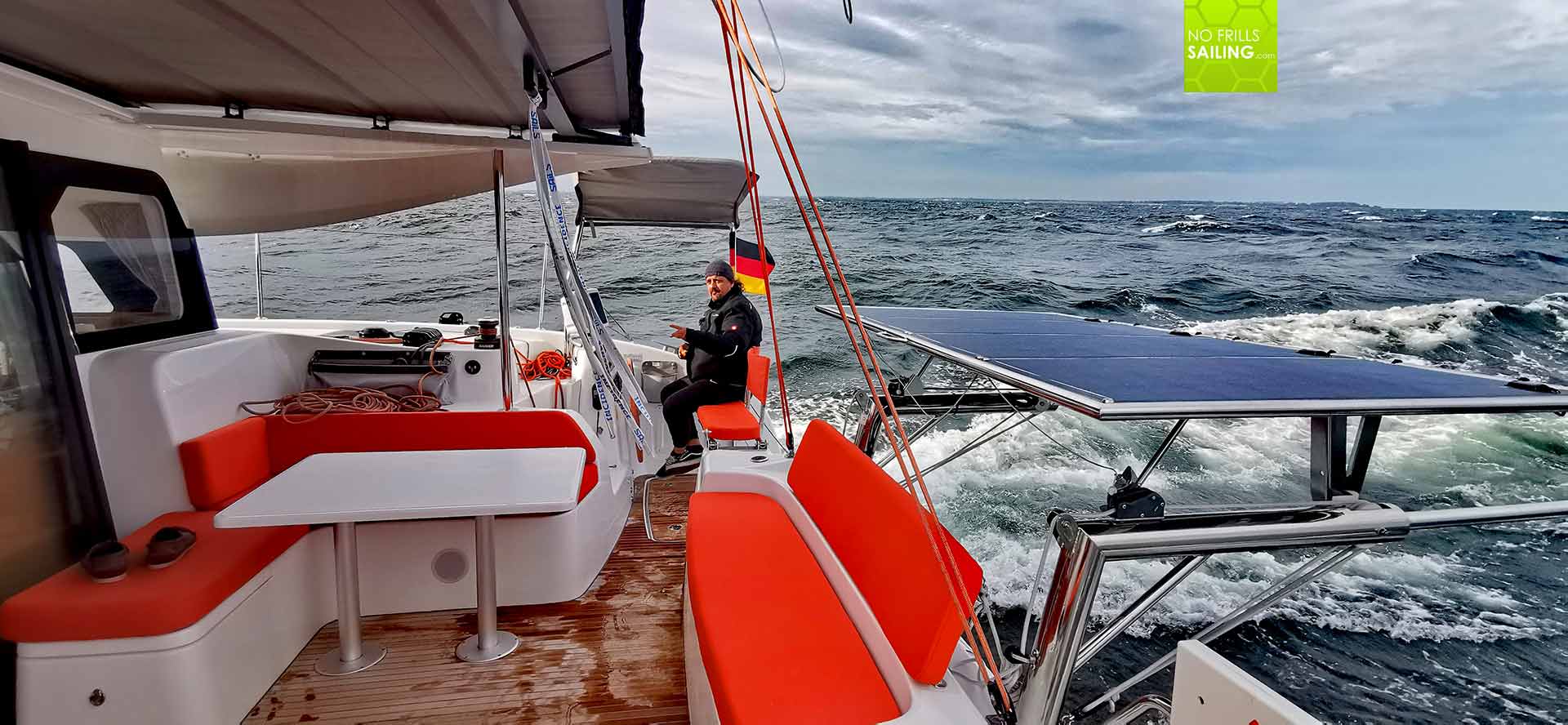
Wind speeds increased further more and during gusts it ticked out at 32 knots which was the record this day. Normal wind speeds hovered around 26 to 28 knots, I remained in first reef for the main, jib still fully unreefed. We went hard upwind and again I was astonished how sturdy the catamaran went forward and cut through the waves. That said, every fifth wave or so doubled in size and the cat crashed into the wall of water, slowing it down significantly and creating huge noise. Not very pleasant. As they say: Bigger boats, less stress. I guess on a 15 metre boat things would have looked differently.

But back to our strong wind upwind beating action. Some 7 miles or one hour after the bridge over the Fehmarn-Sound I tacked. After having the boat brought to a nice upwind angle (some 45-50 degrees AWA) and the boat picking up speed again, I activated the autopilot and was happy that I could aim directly for Travemuende. I told Olaf: “That´s 25 miles, 4 hours!”. But after one hour I noticed that, although being on course, our bows did not point towards the white beacon light on top of the high rise Maritim hotel clearly visible in the distance but towards a landmark nearby: On 7 miles distance the catamaran had made a stunning 3 mile leeway!
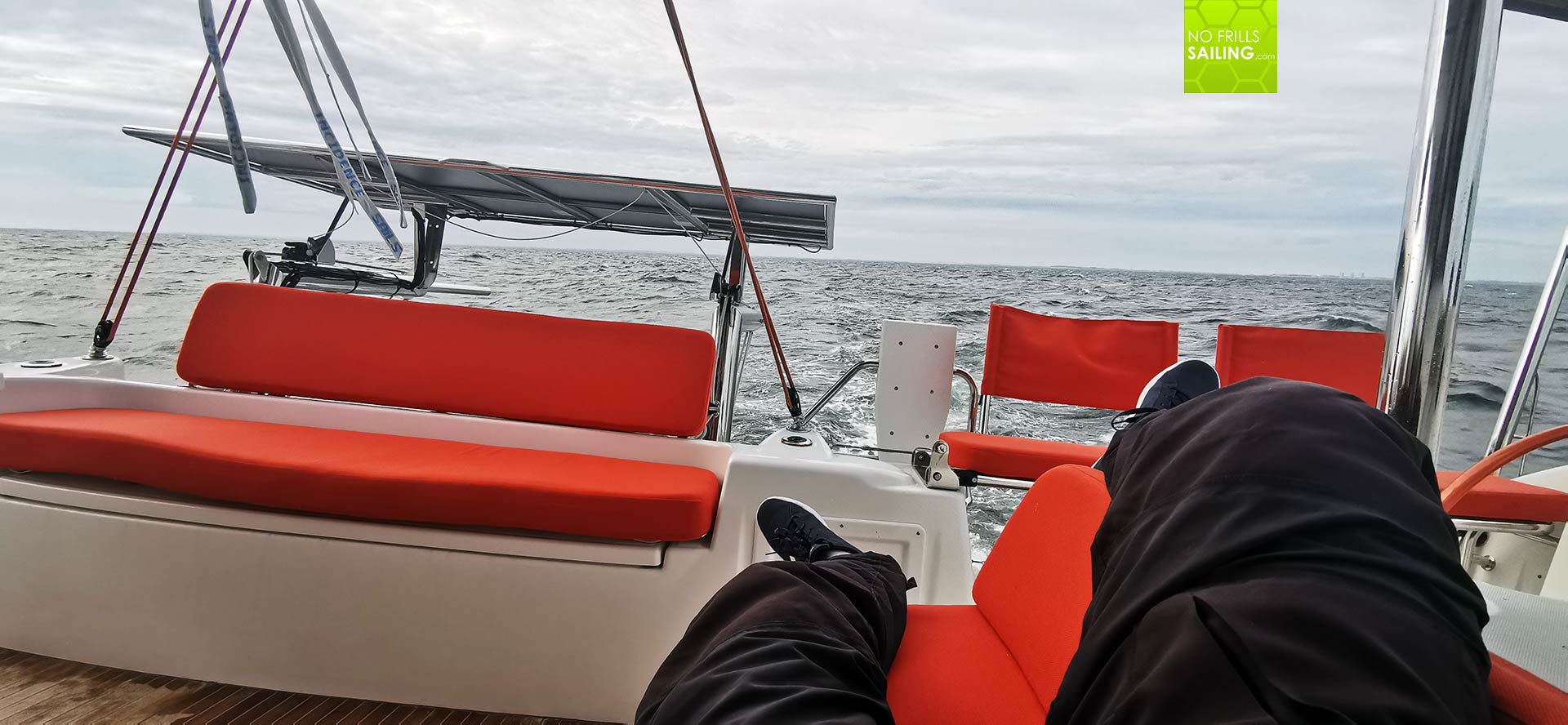
So I tacked, made good another hour to windward portside, tacked again and aimed at Travemuende. Same here, again, after a few miles: The leeway when going upwind was tremendous! I knew that a catamaran, having no stabilizing keel-fins, has more leeway going upwind than a multihull, but this lesson was truly a big one! It took me no less than eight (!) tacks to finally reach Travemuende. To see the leeway drift on the plotter was astounding, I´ve never seen something like this before. In the end, of the 30 miles beeline trip from North to South of Luebeck Bay it took is not 4 hours but a whopping 50 miles upwind beating, done in 8.5 hours! That´s just … wow.
Finally there: What have I learned
Now, instead of arriving in daylight, we reached Travemuende in the darkness, which of course apart from being a bit exhausted was no problem. The last miles had been a true pleasure, wind was down to 19 knots due to terrain shading and there had been no waves whatsoever – the log clocked in at 9 knots upwind speed which was amazing! Hadn´t it been for almost double in sailed distance, this would have been great fun. People who by a catamaran must know this: Leeway is extreme, time and distance will double. Unless, of course, you take in the sails and push the boat straight up against the swell by the Diesels, which of course breaks the heart of every sailor.
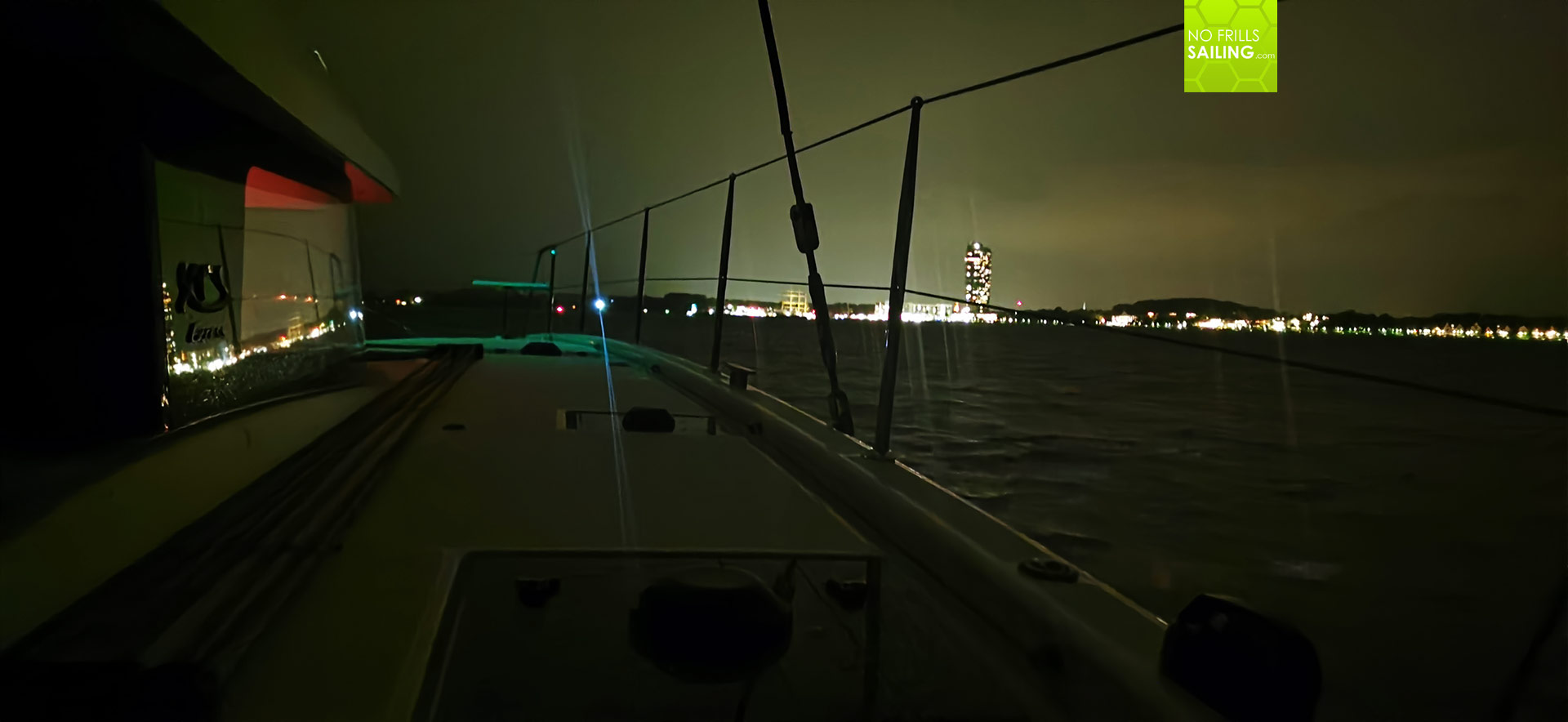
Arriving to Luebeck in almost calm conditions we landed the boat and tied her up safely. It was 0100 o´clock the following day and you can imagine how tired and worn we had been, as well as happy. Of those roughly 900 miles delivery trip of this catamaran, I had sailed her for some 650 miles. Most of them in not-so-favourable wind and wave-conditions, almost never on those “catamaran” points of sail which are the reaching courses. So I can only tell stories of sailing a cat in harsher environment.
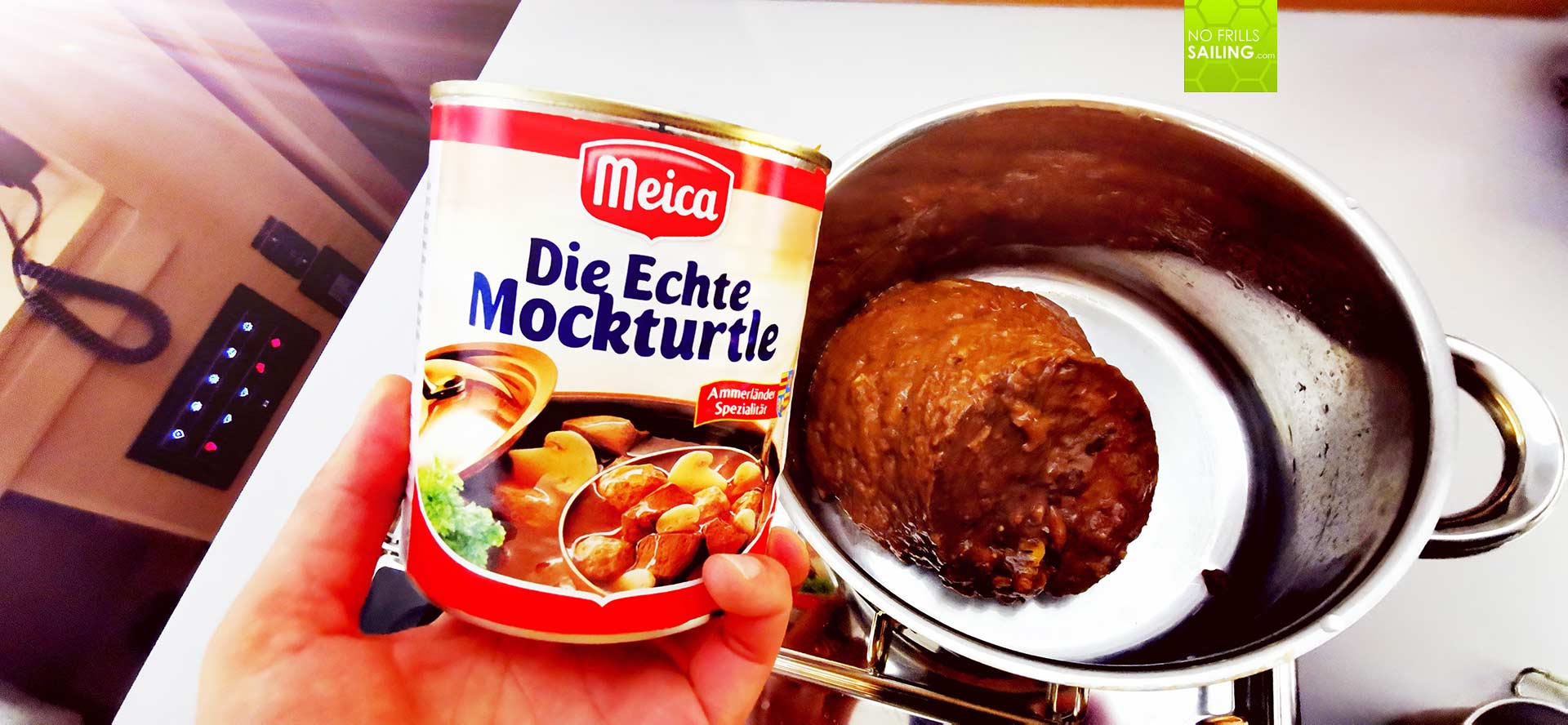
But I must conclude that even this “small” 38-feet cat behaved much, much better than I had expected. I am not saying this because we sell these cats, but honestly as a skipper and sailor. The cat is much more stable than I had thought and even in really heavy seas like those I experienced for that stormy night on the first cat, MAUSI, I never felt uncomfortable or even unsafe. Except for the “poor” leeway performance upwind, the outcome sailing-wise is cool as hell! The cat can sail indeed and even a production boat that is cruising-oriented like this Excess will produce astonishing sailing pleasure for sure. Living and boating conditions are almost perfect. Space and volume create a loft-like atmosphere that is unprecedented and simply cannot be matched by any multihull, unless it´s an Oyster. Even this smallest of Excess-cats is huge in the feel it transmits, perfect for a cruising family or a couple.
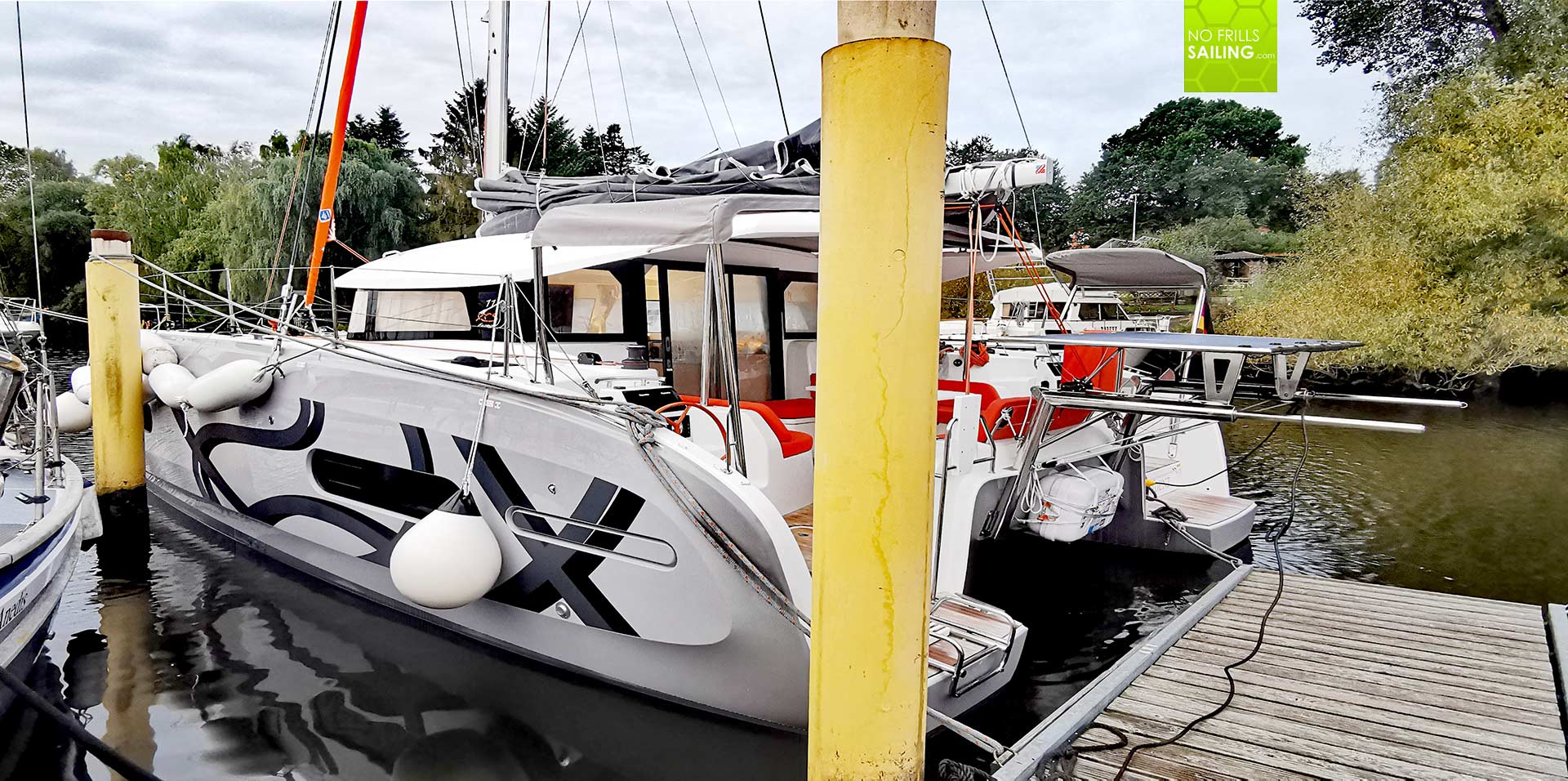
Size comes with downsides, of course: I still do not fancy manoeuvering much. It might get better with time but for me, personally, I need the monohull-feel. In narrow marinas the sheer size of the boat and the fact that even a small breeze may make her drift instantly. I would say this needs not just a good man on the helm (aka throttle) but also a competent and quick crew member on the mooring lines. Am I a cat-man now? Well, I totally see the nice sides of a cat. And I will return with joy and excitement for sure if I get to deliver the next boat. For me personally? I need the heeling, I need the motion and I am still – and surely will remain to be so – a mono-guy (getting “multi” every now and then).
You may find interesting to read these as well:
All articles related to my 2 Excess catamaran deliveries #excesscatamaran
First time on a cat
